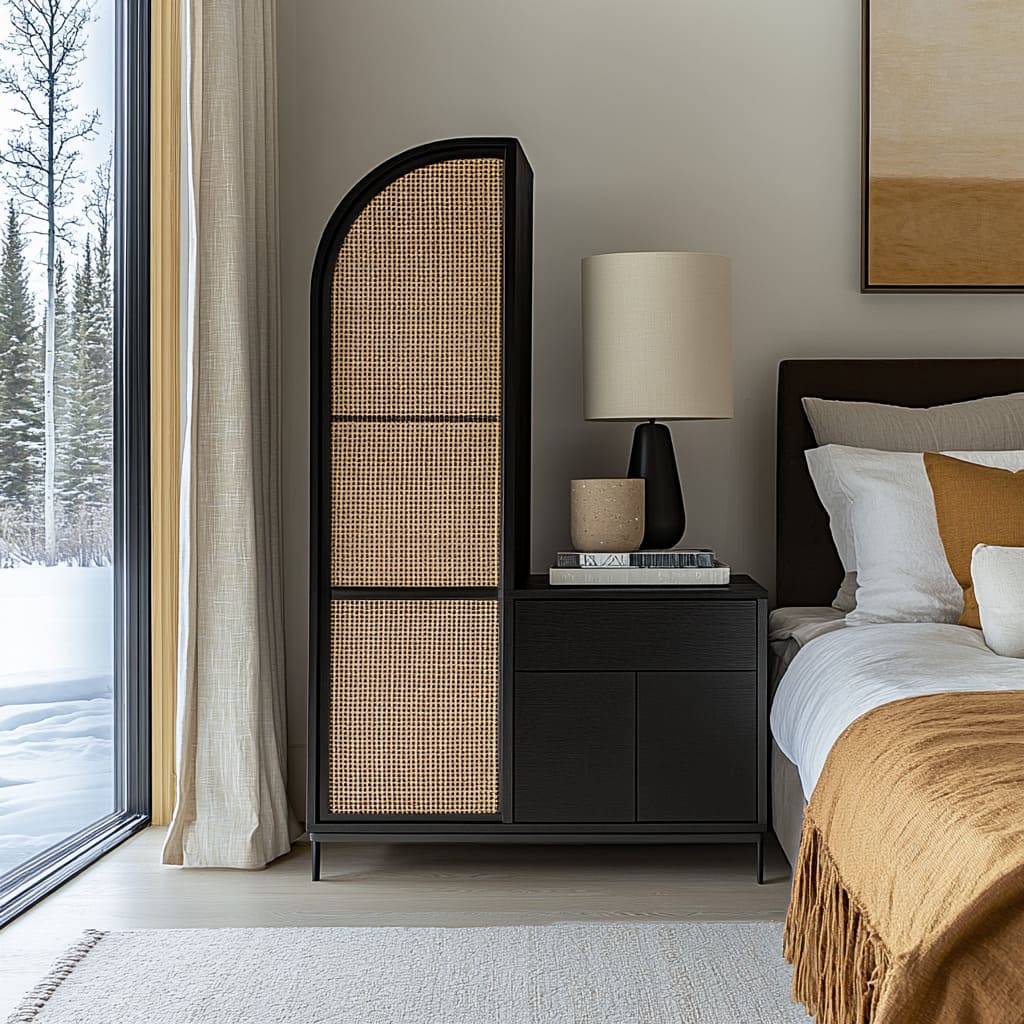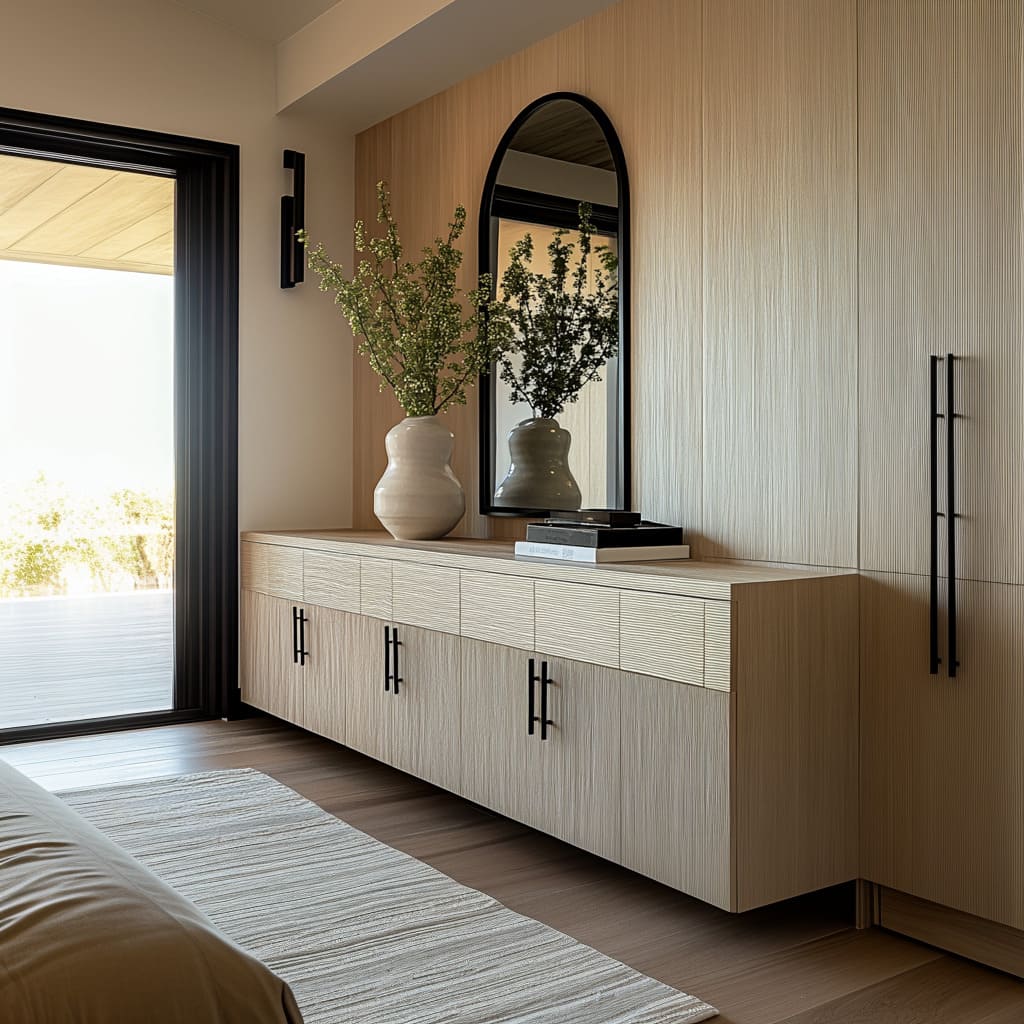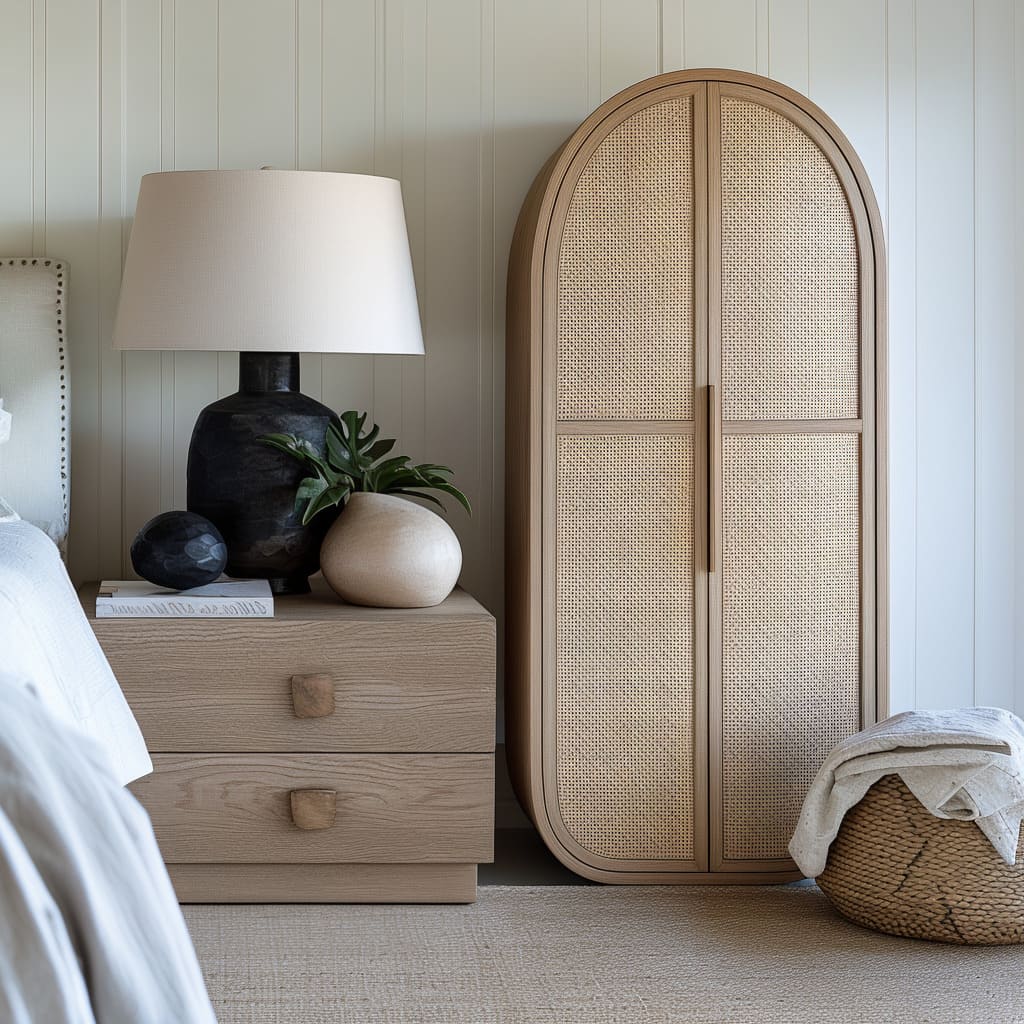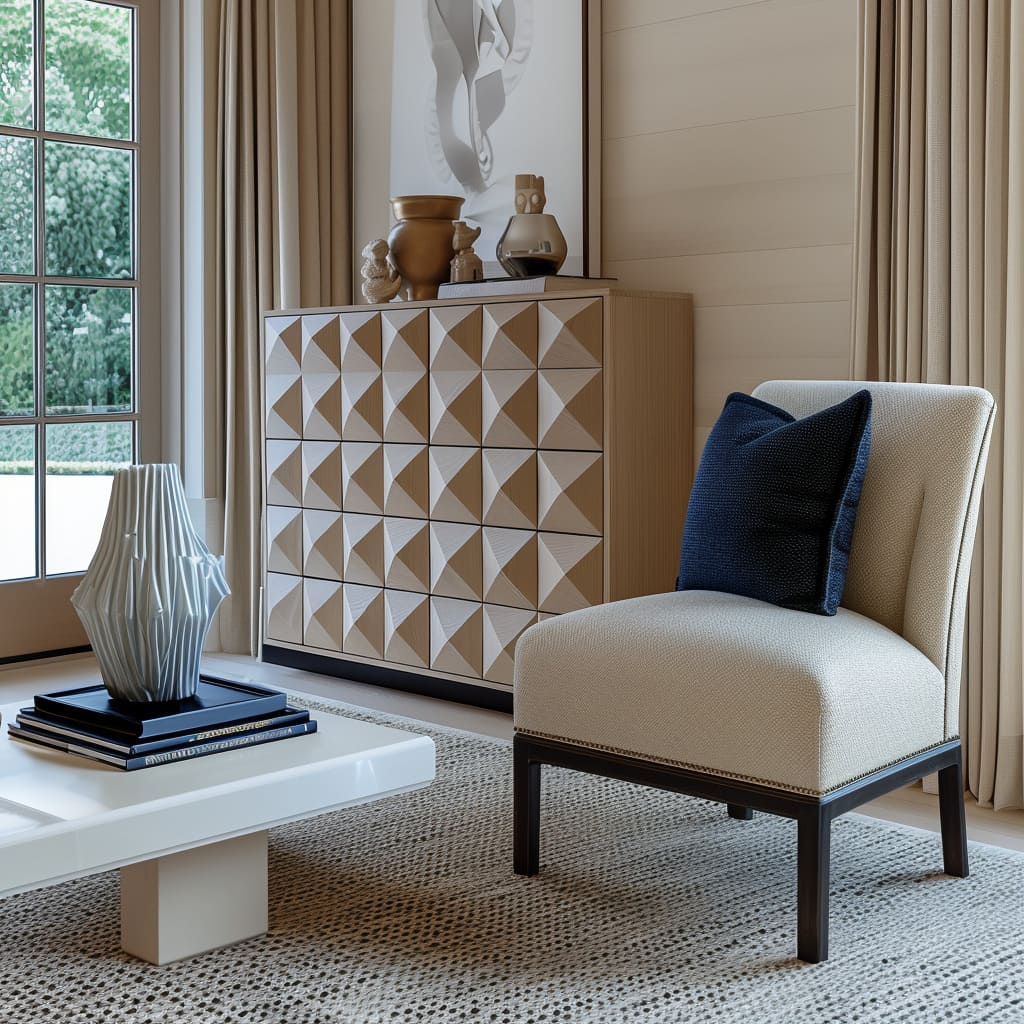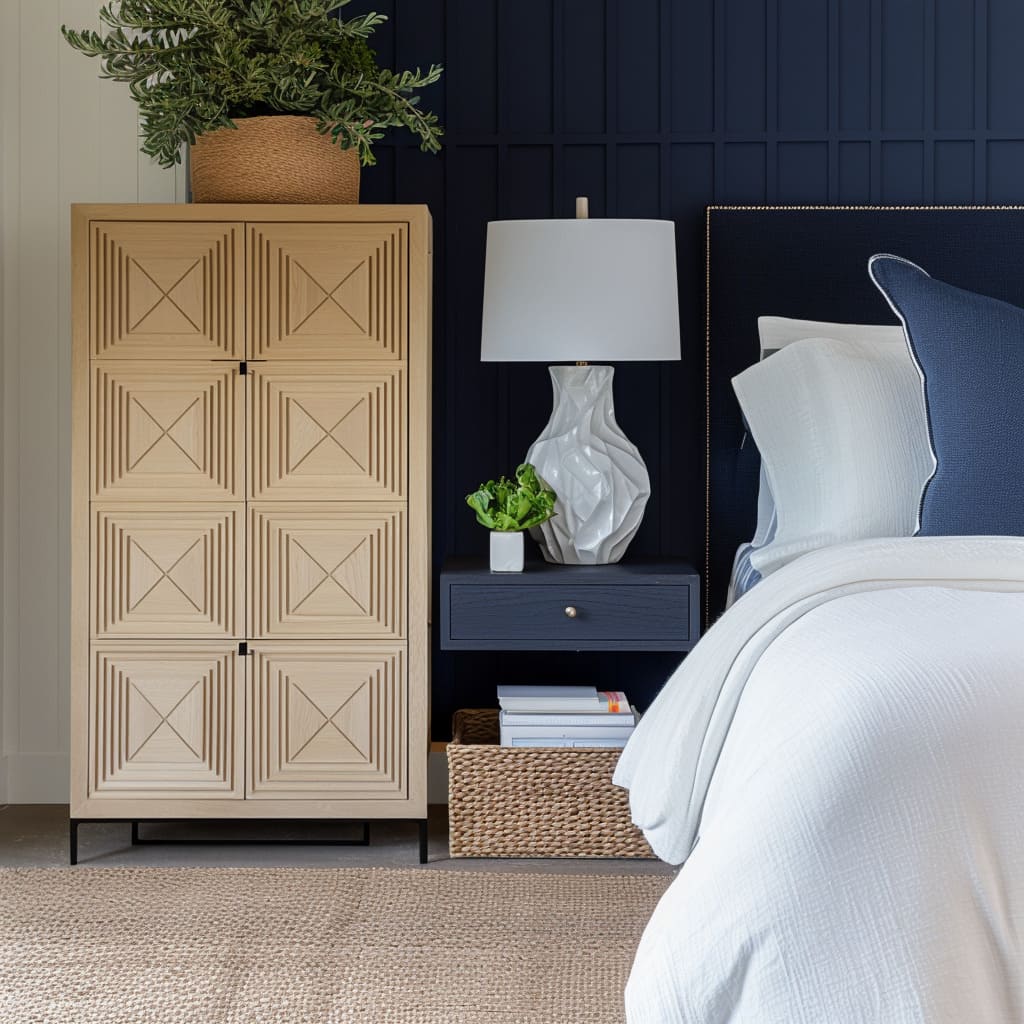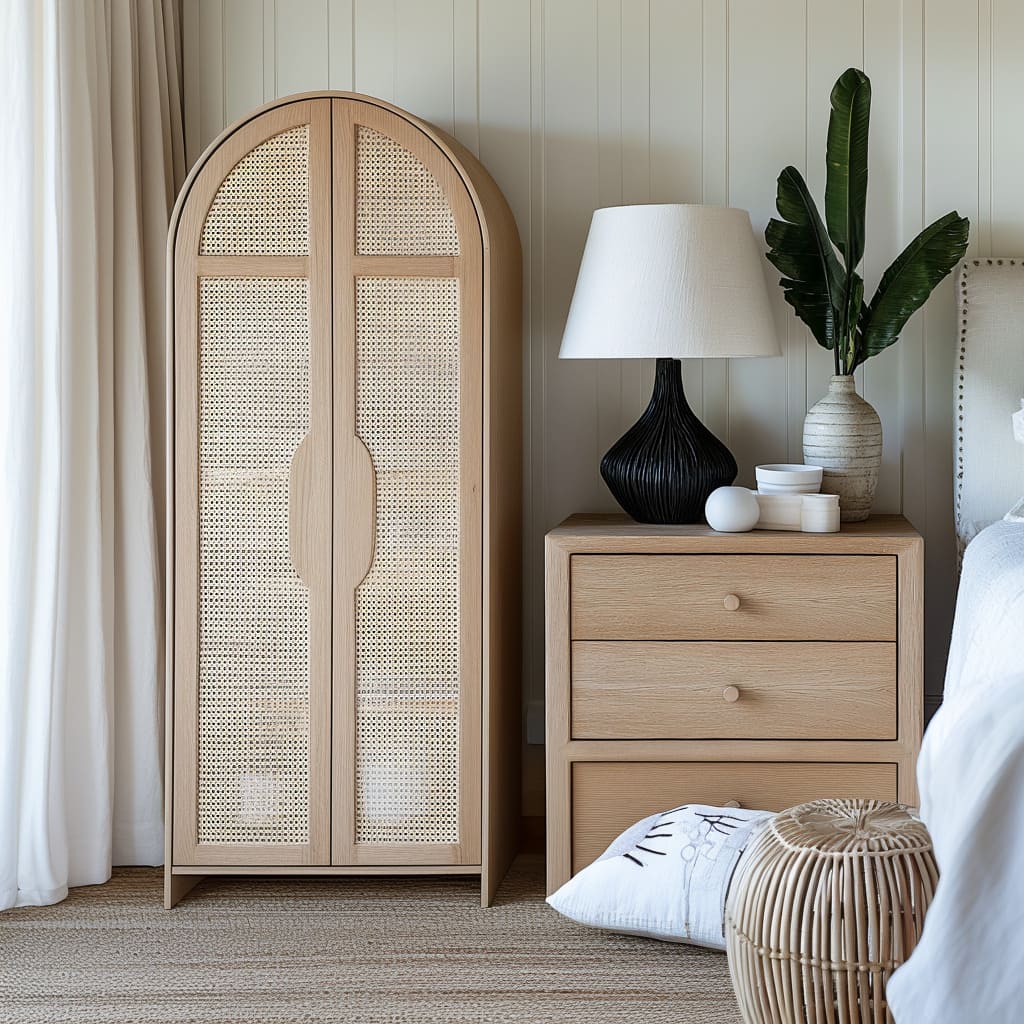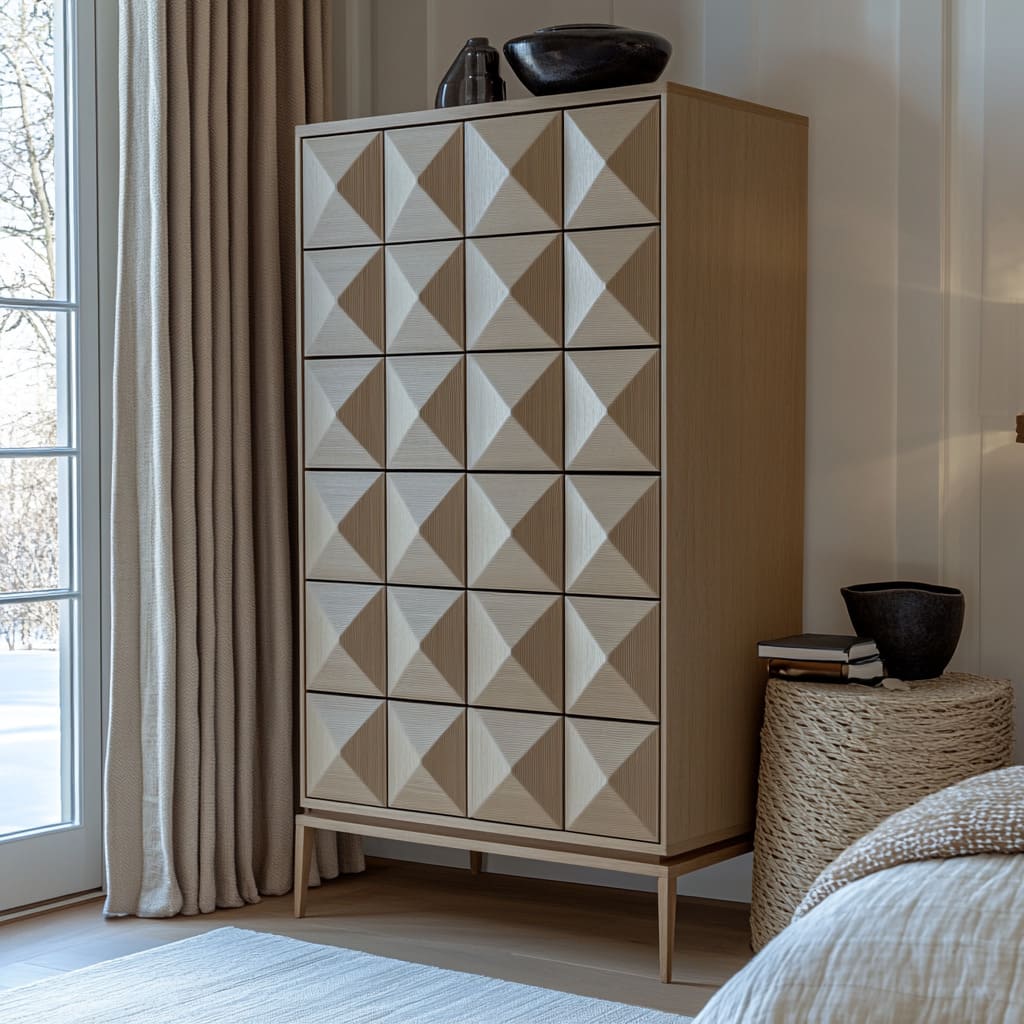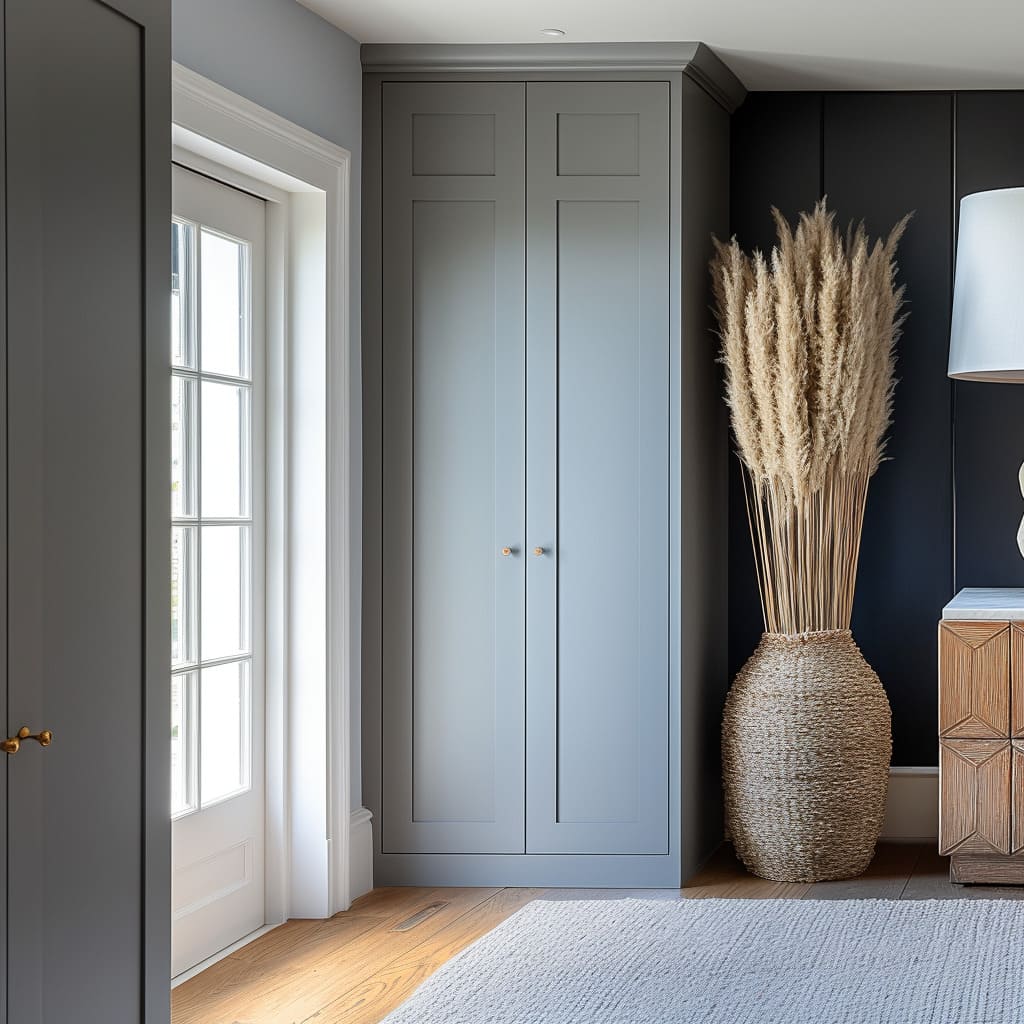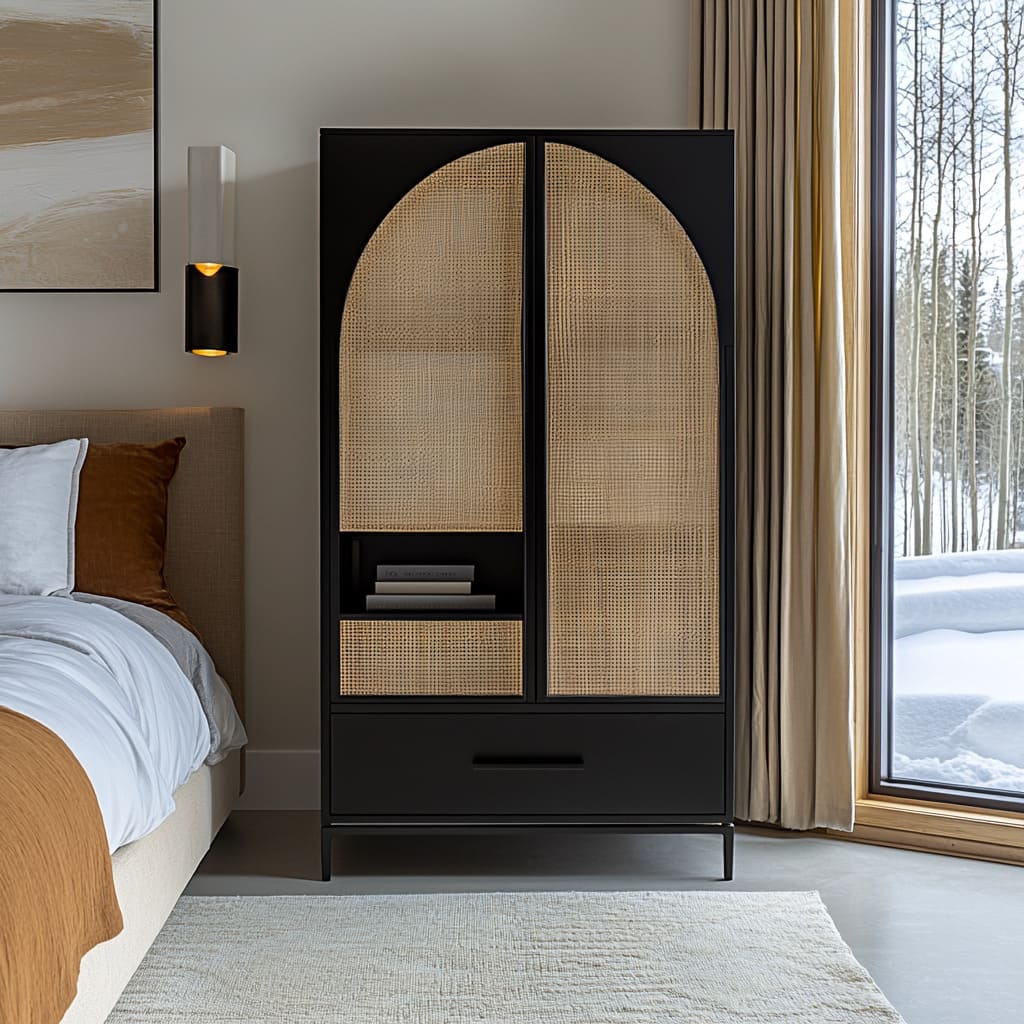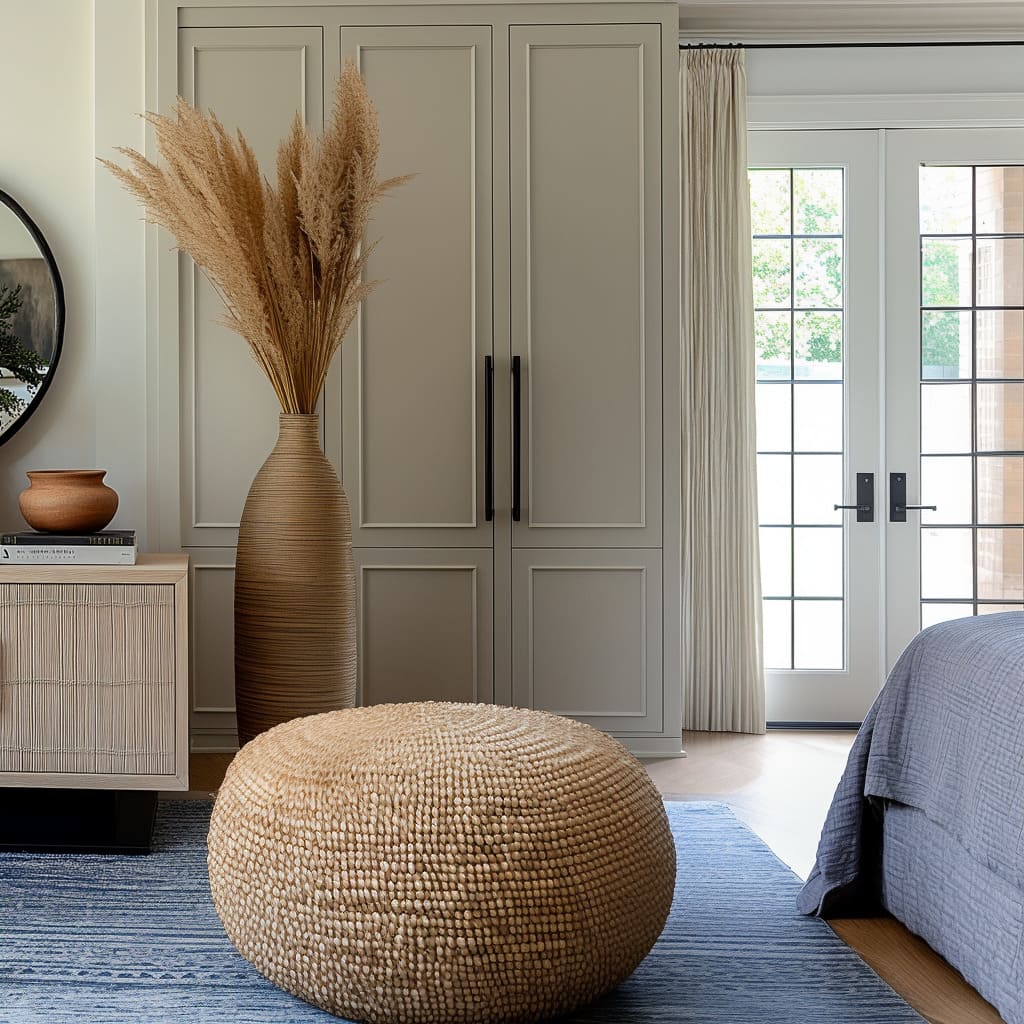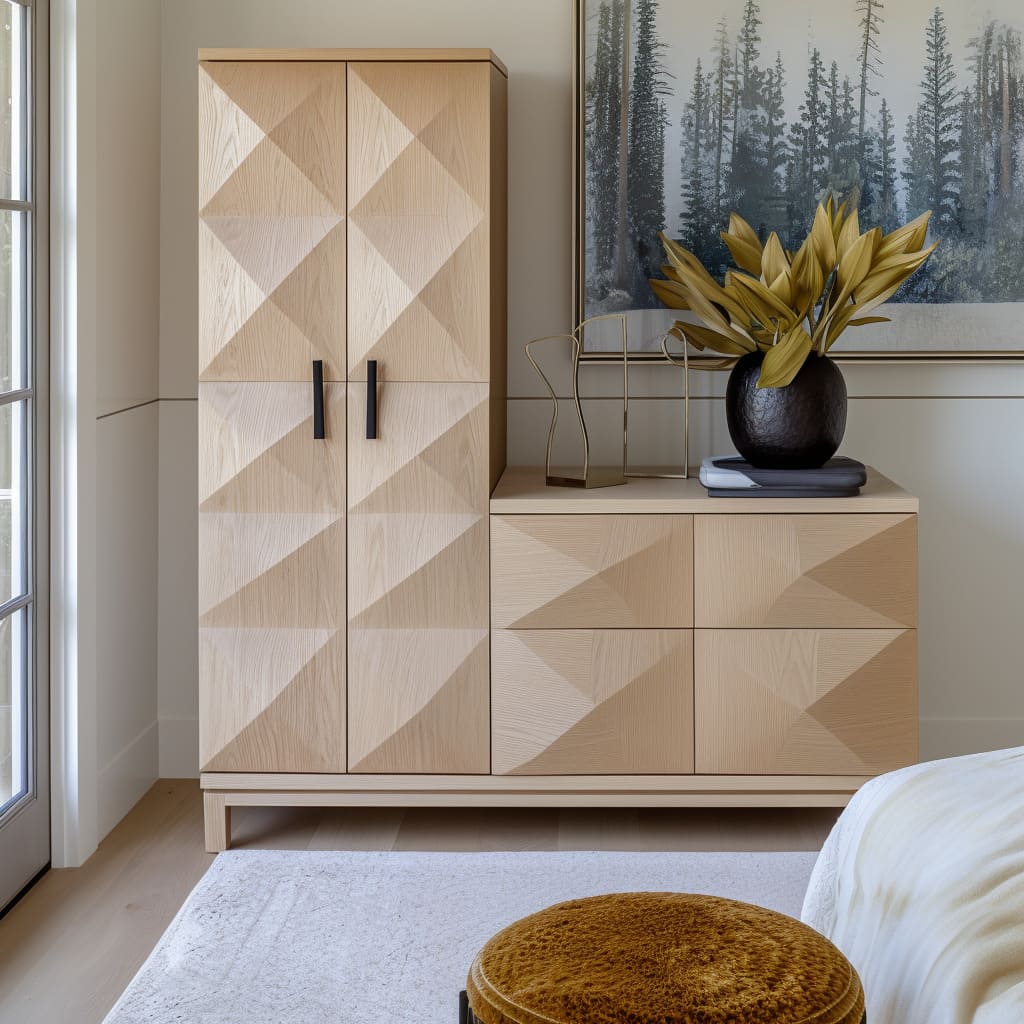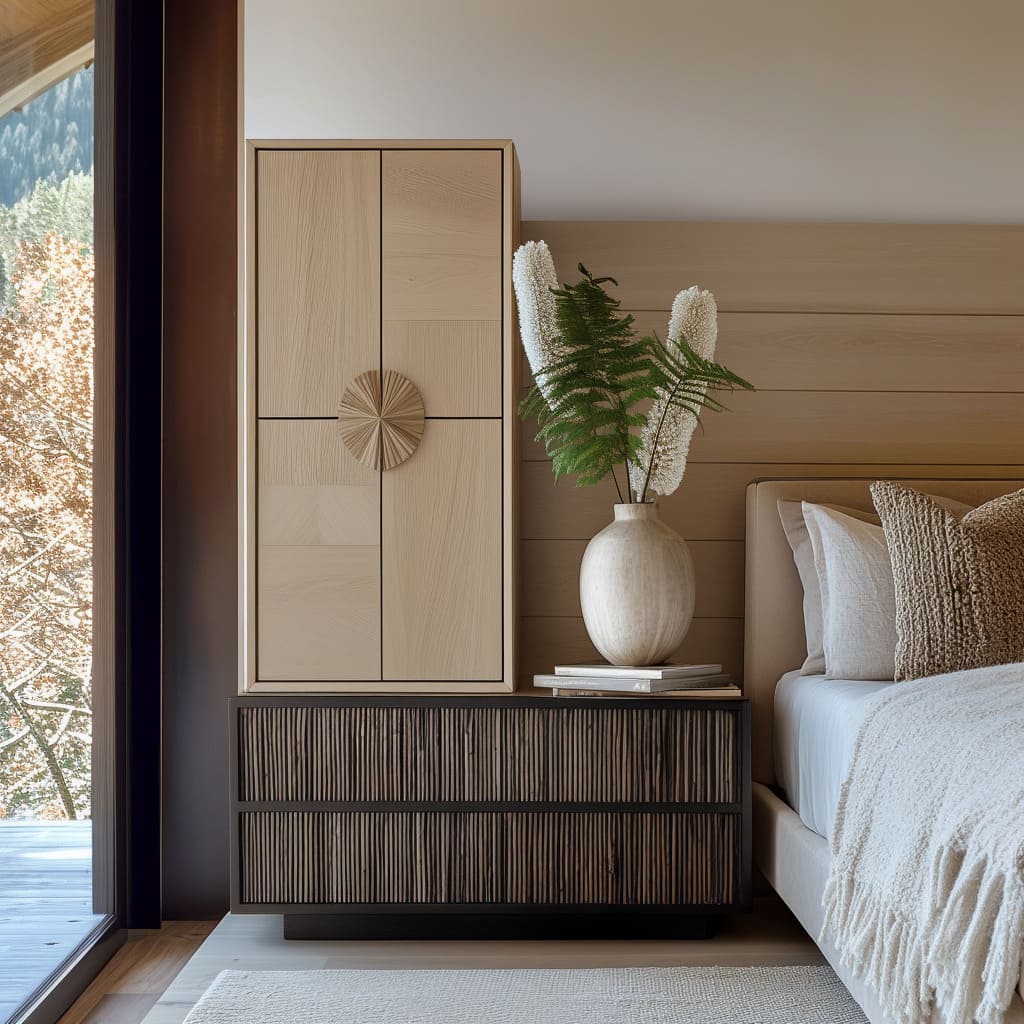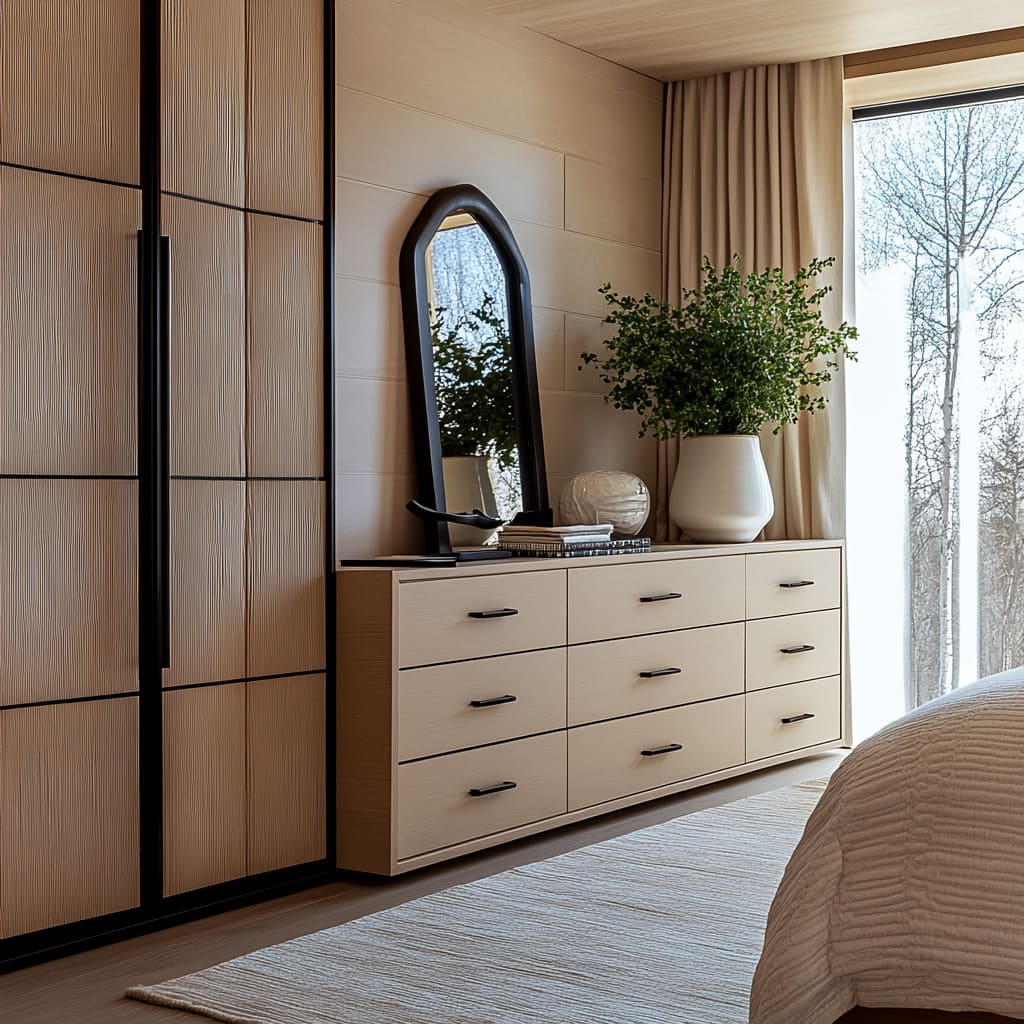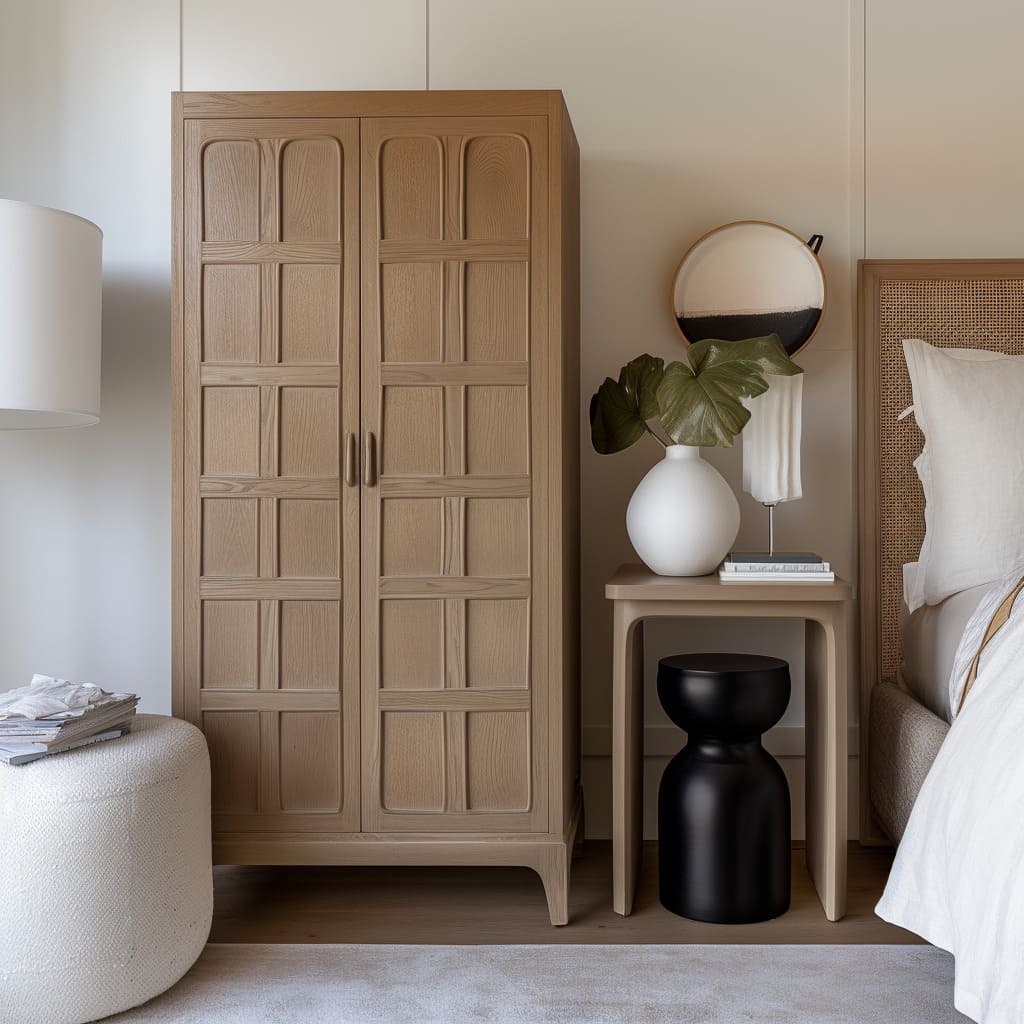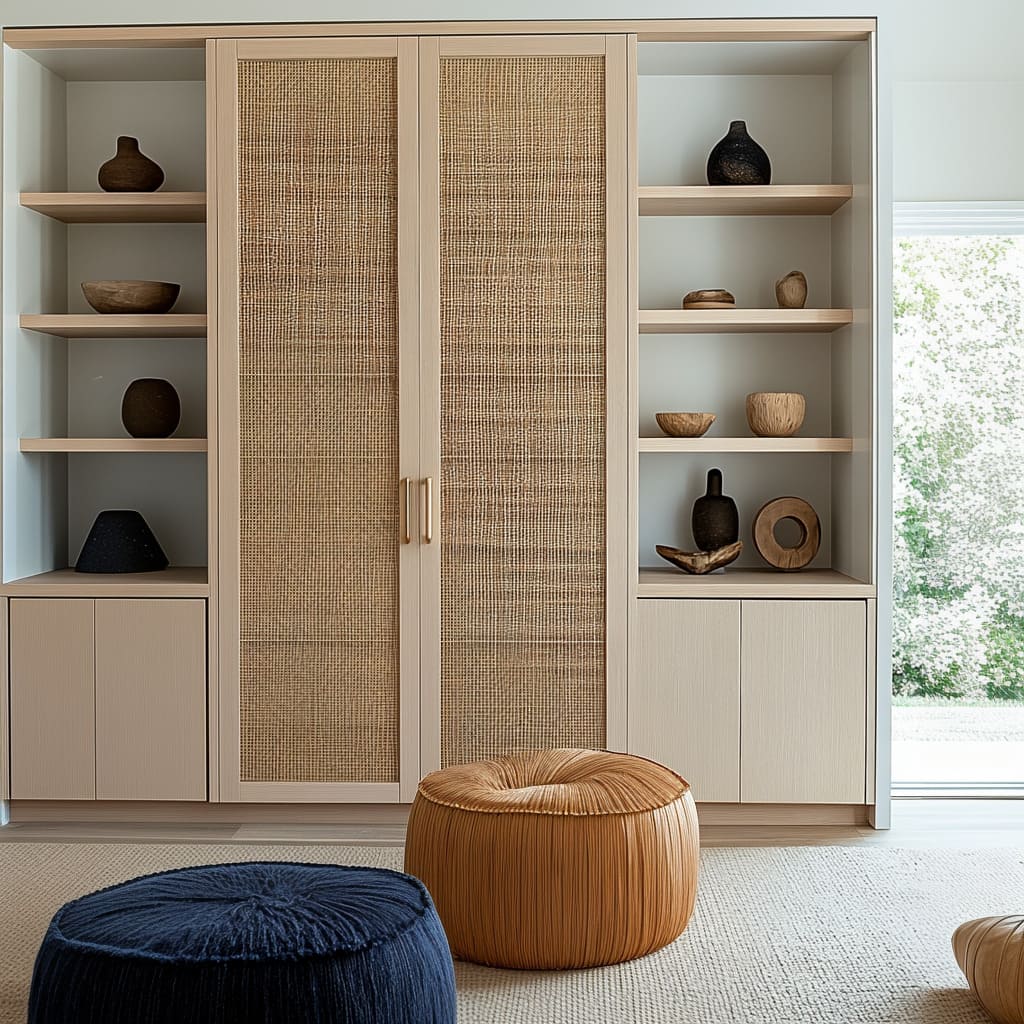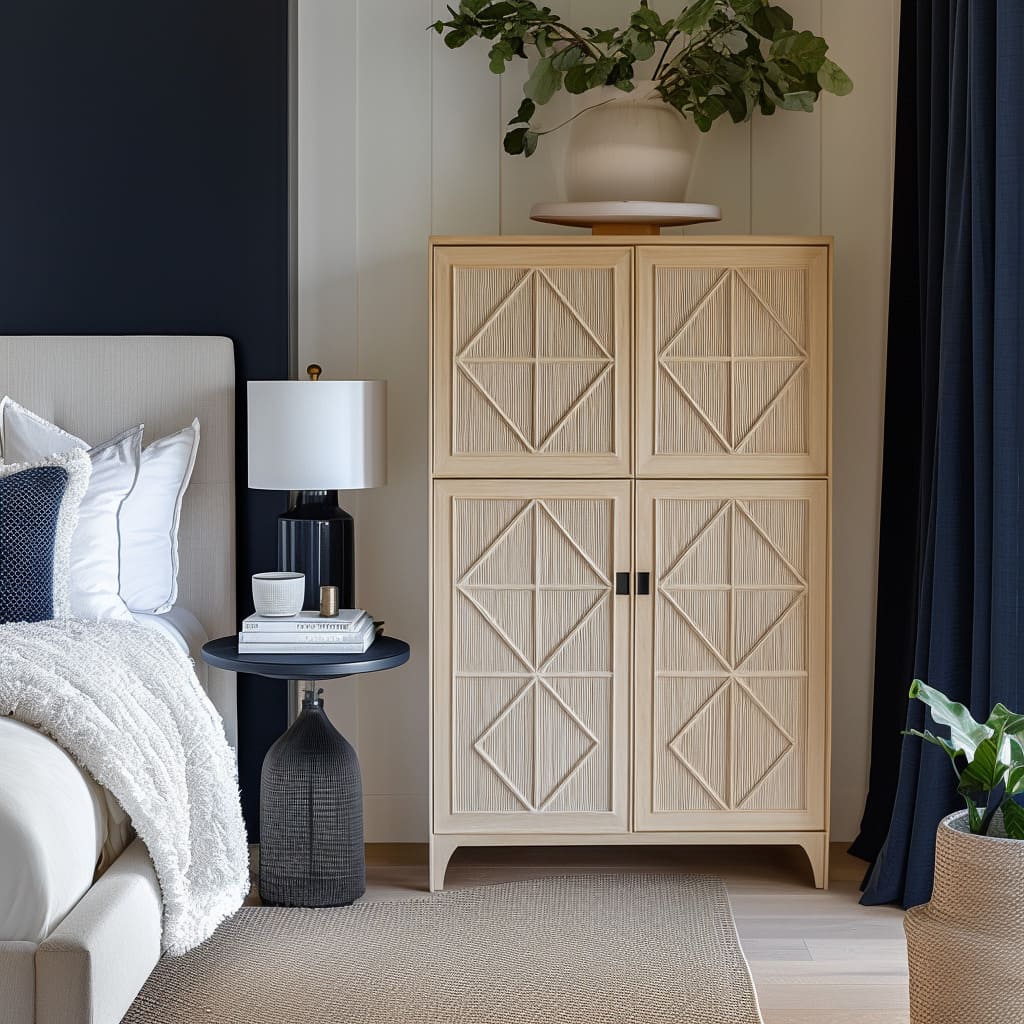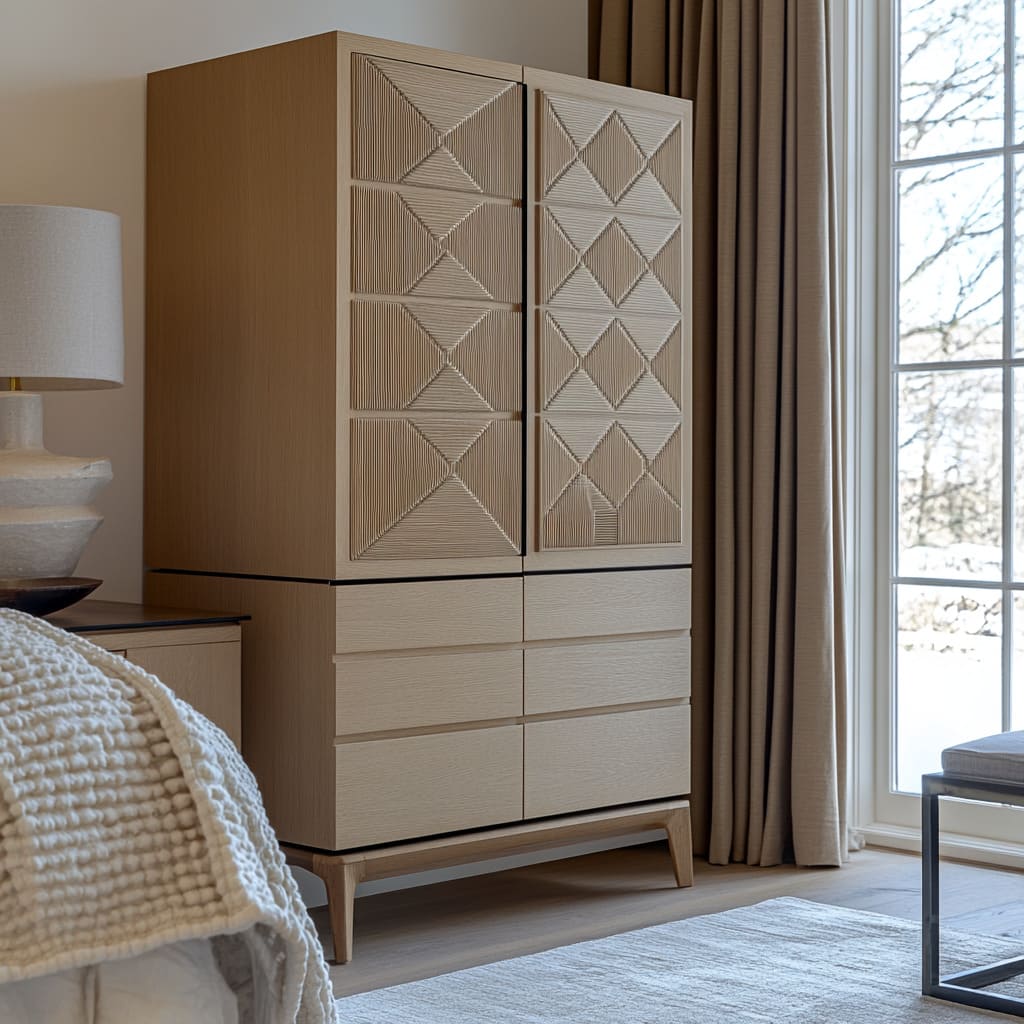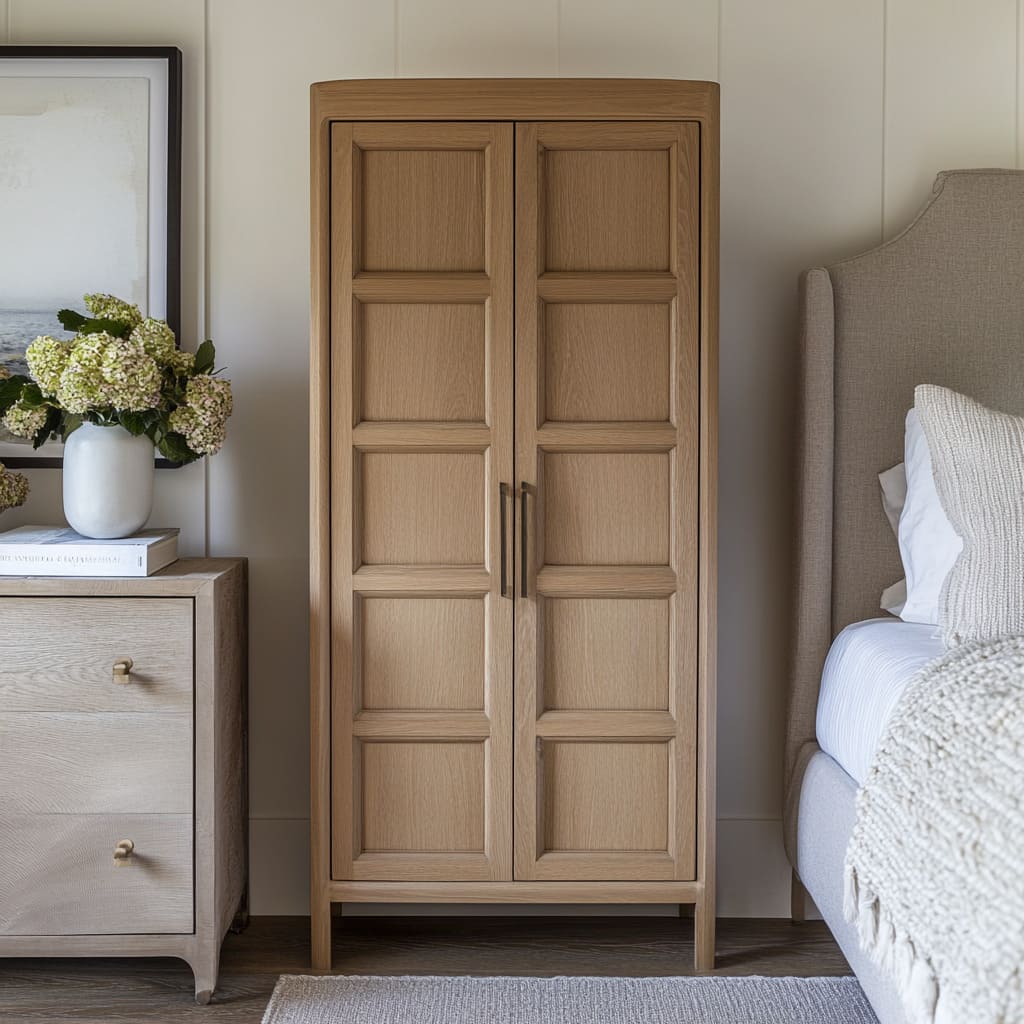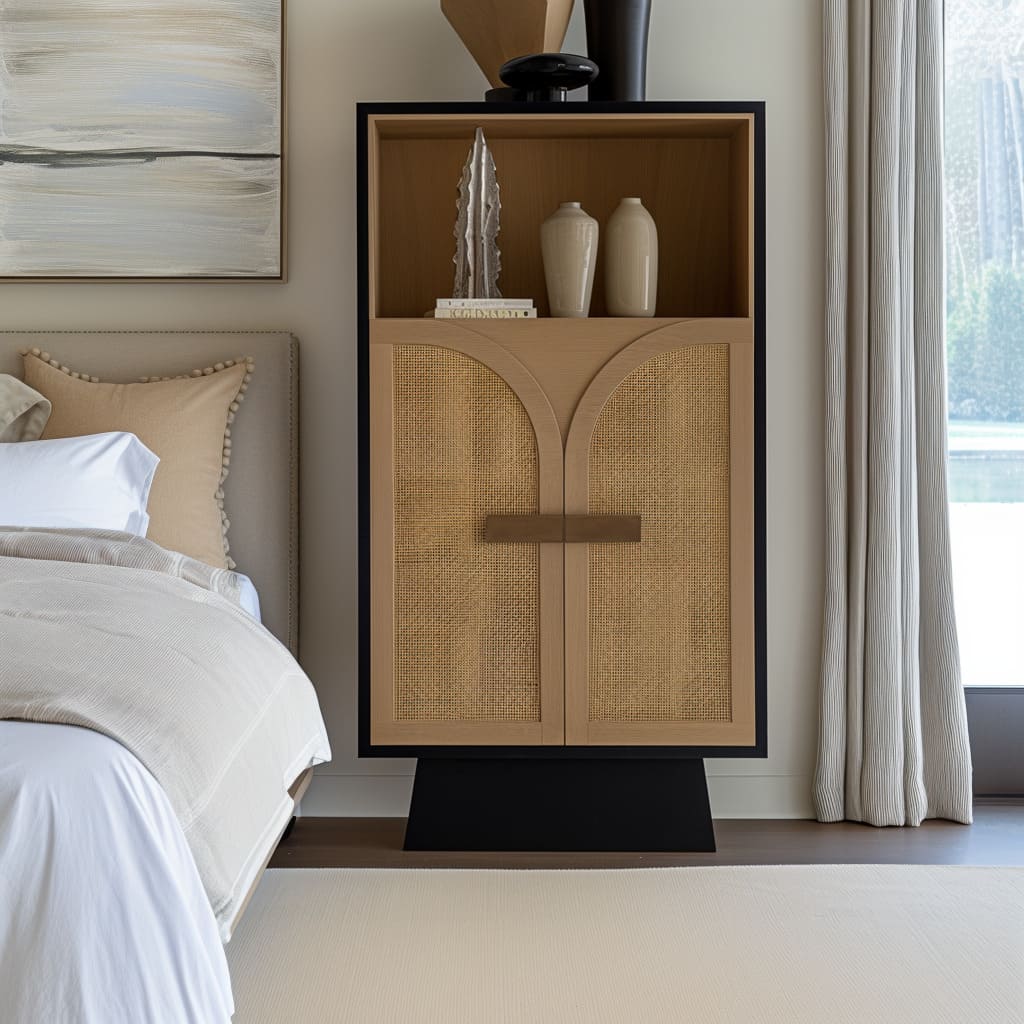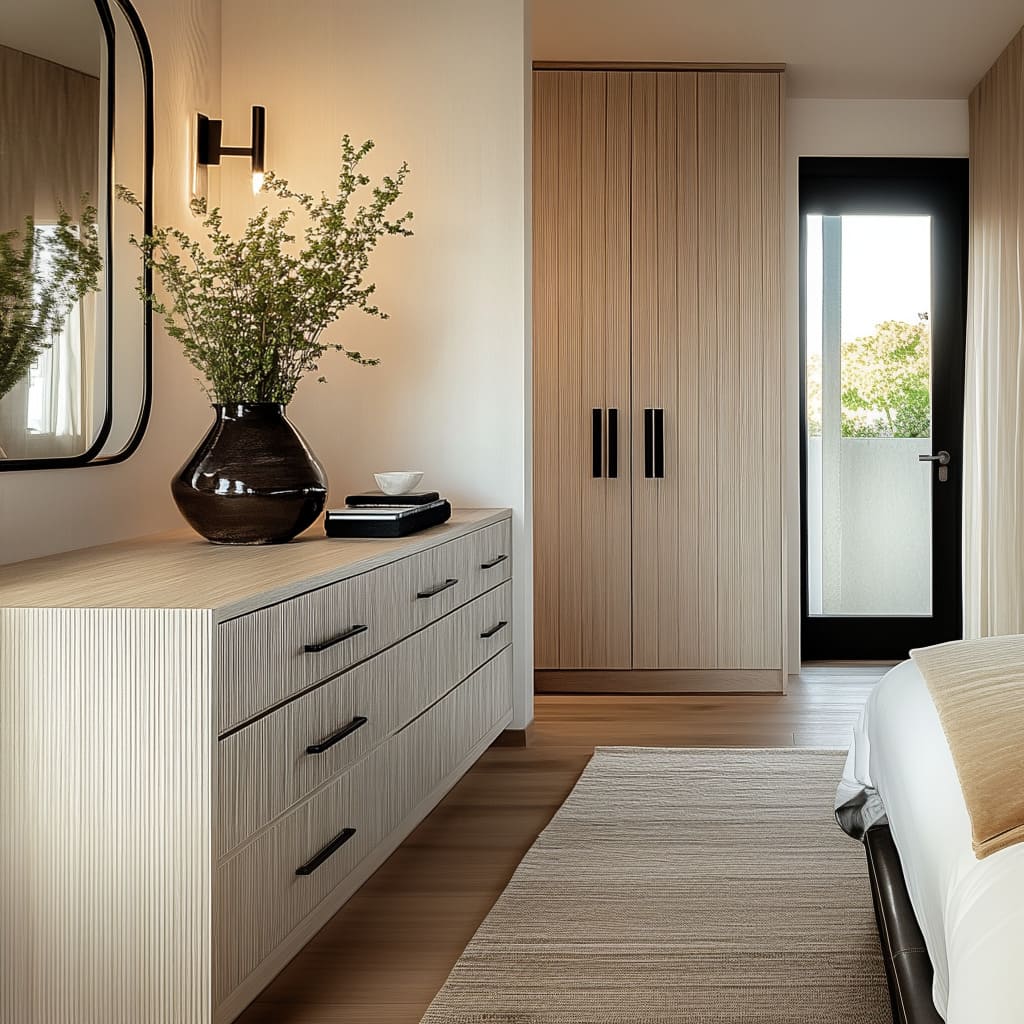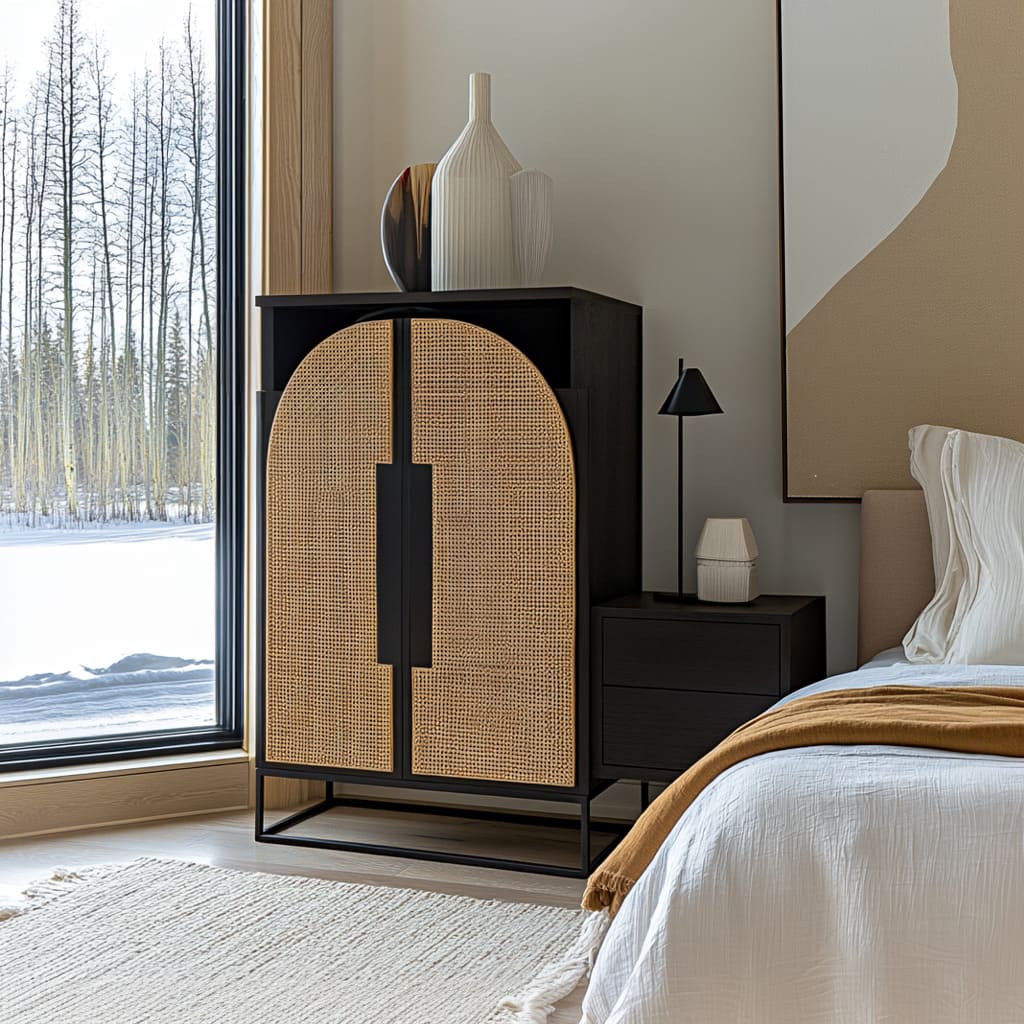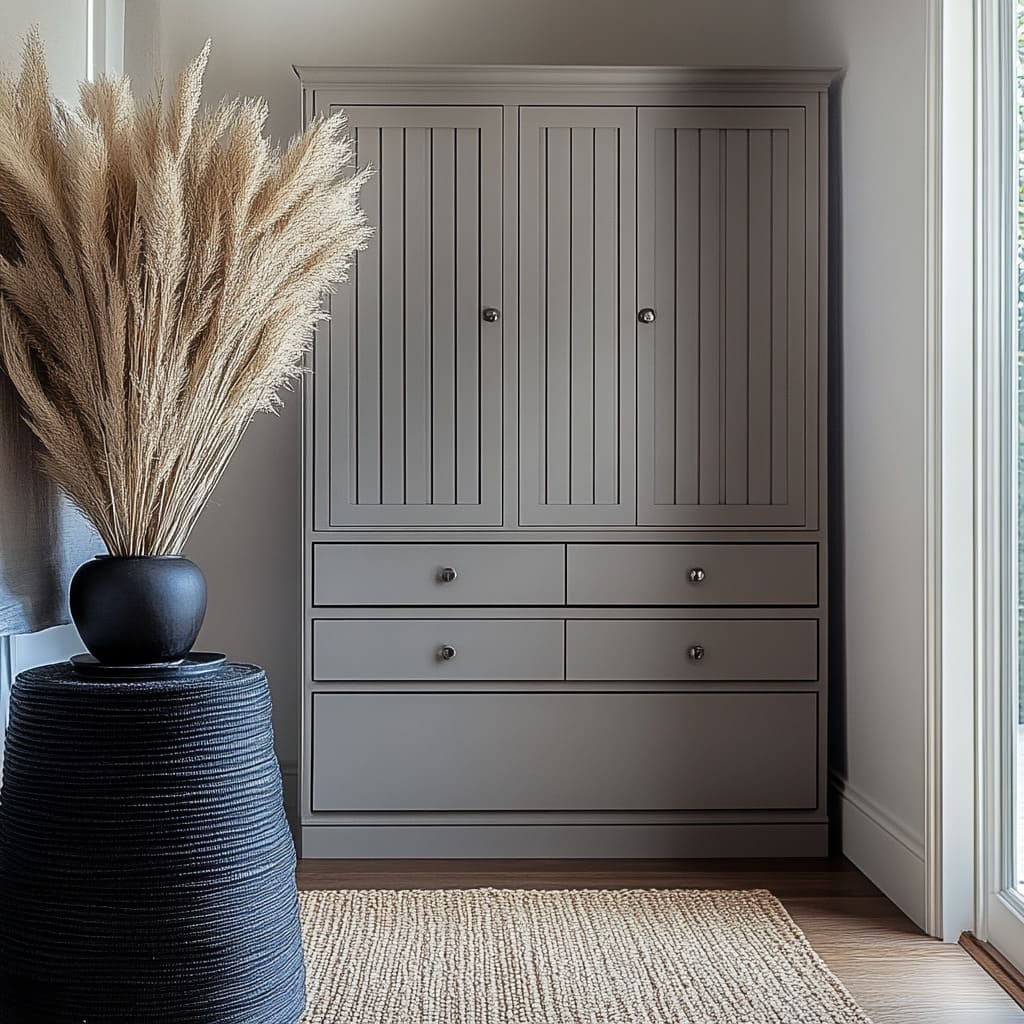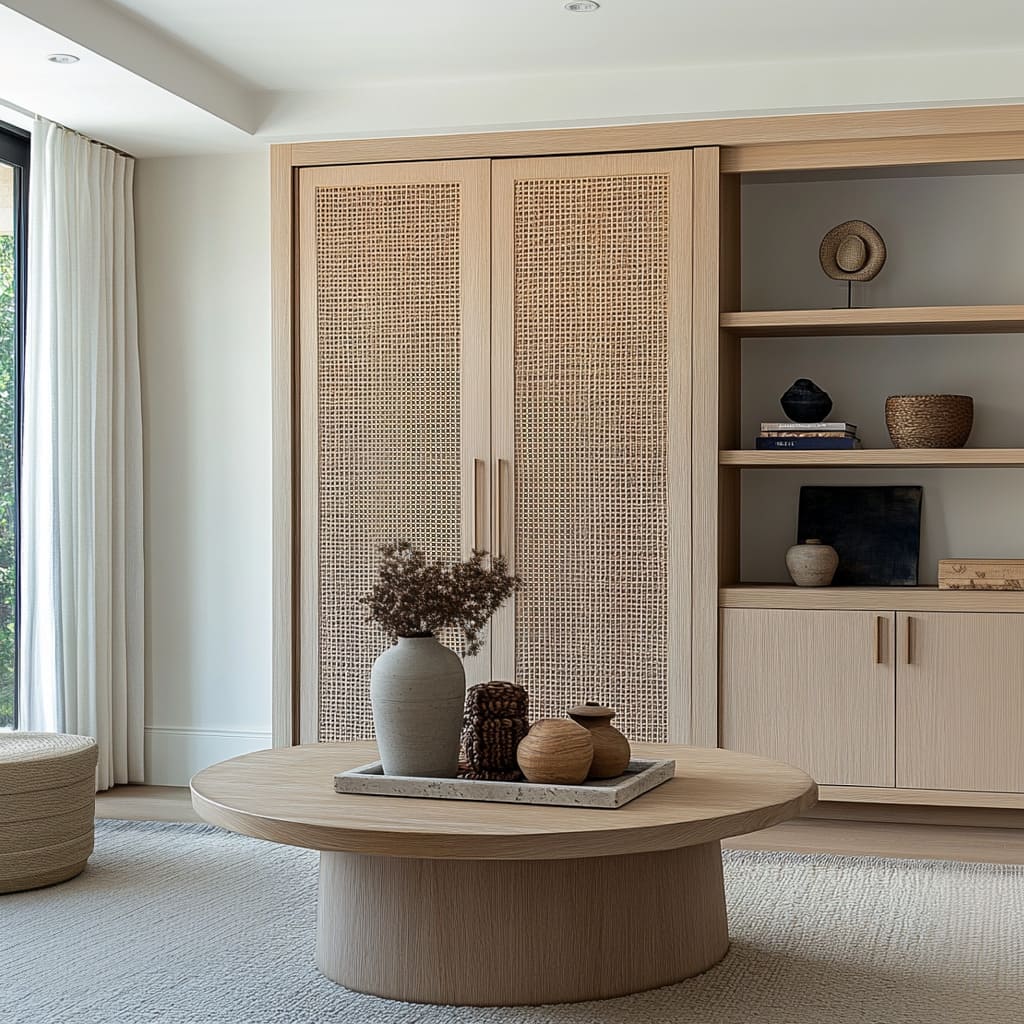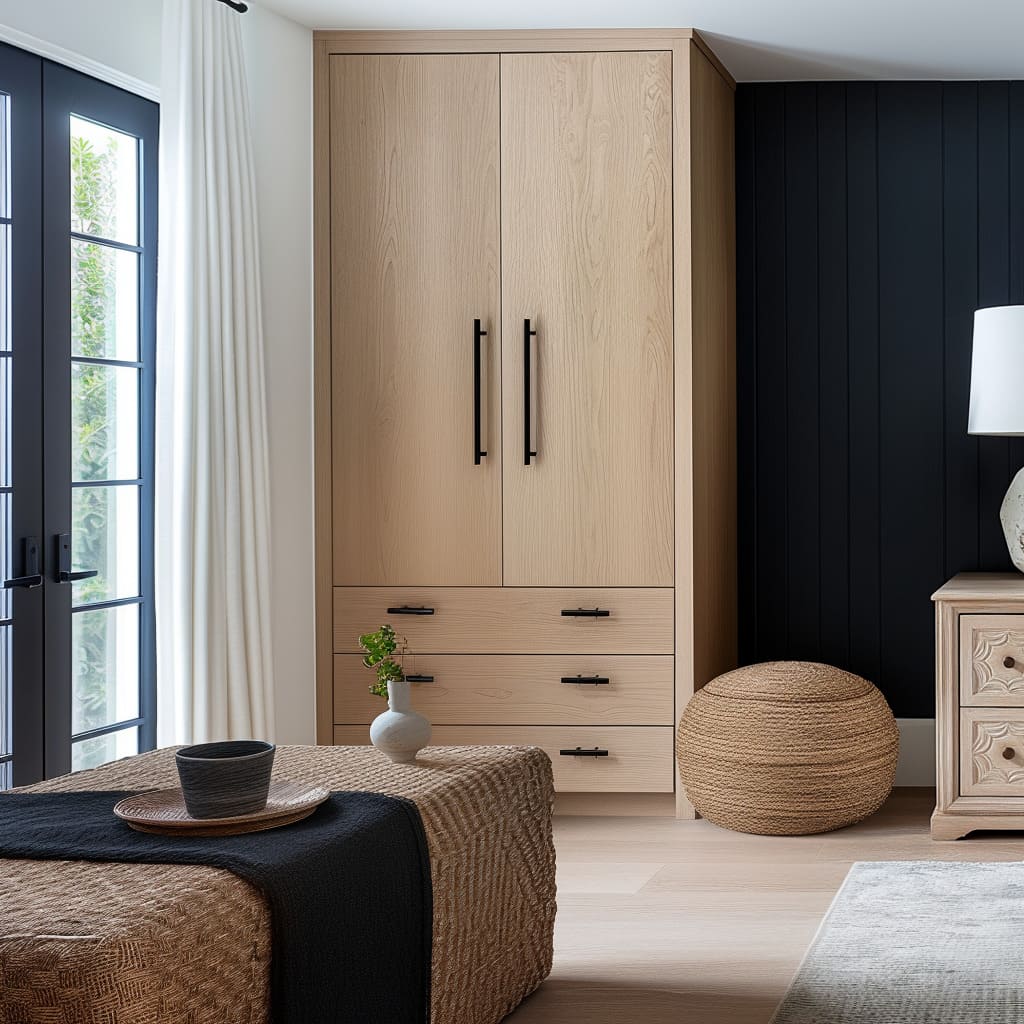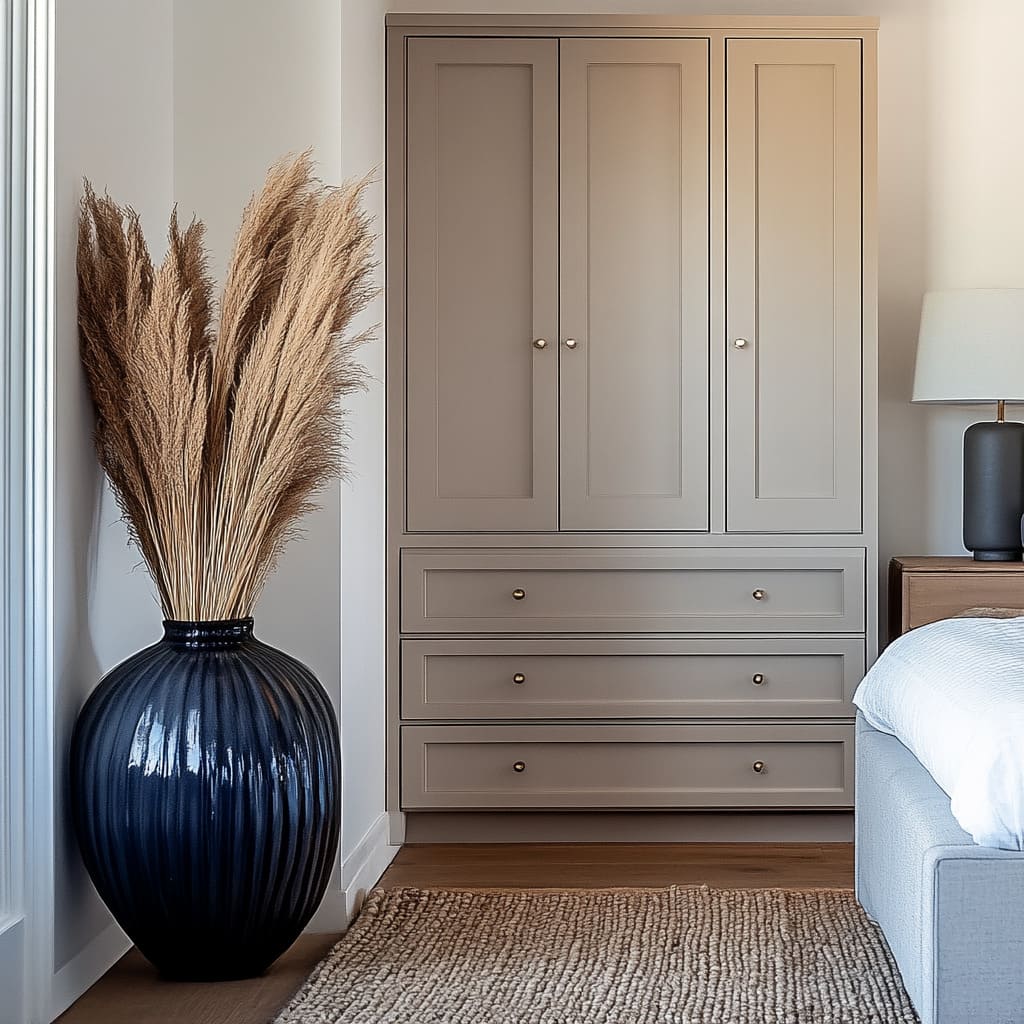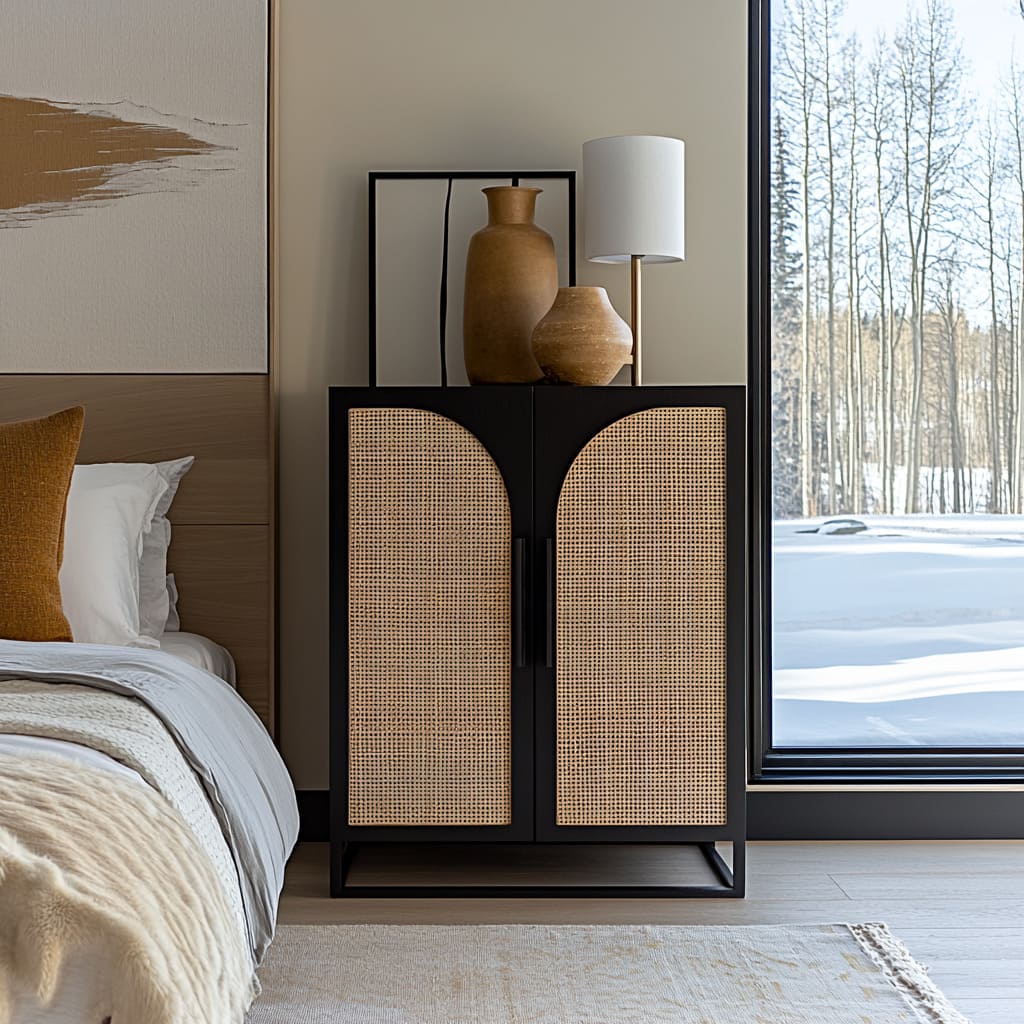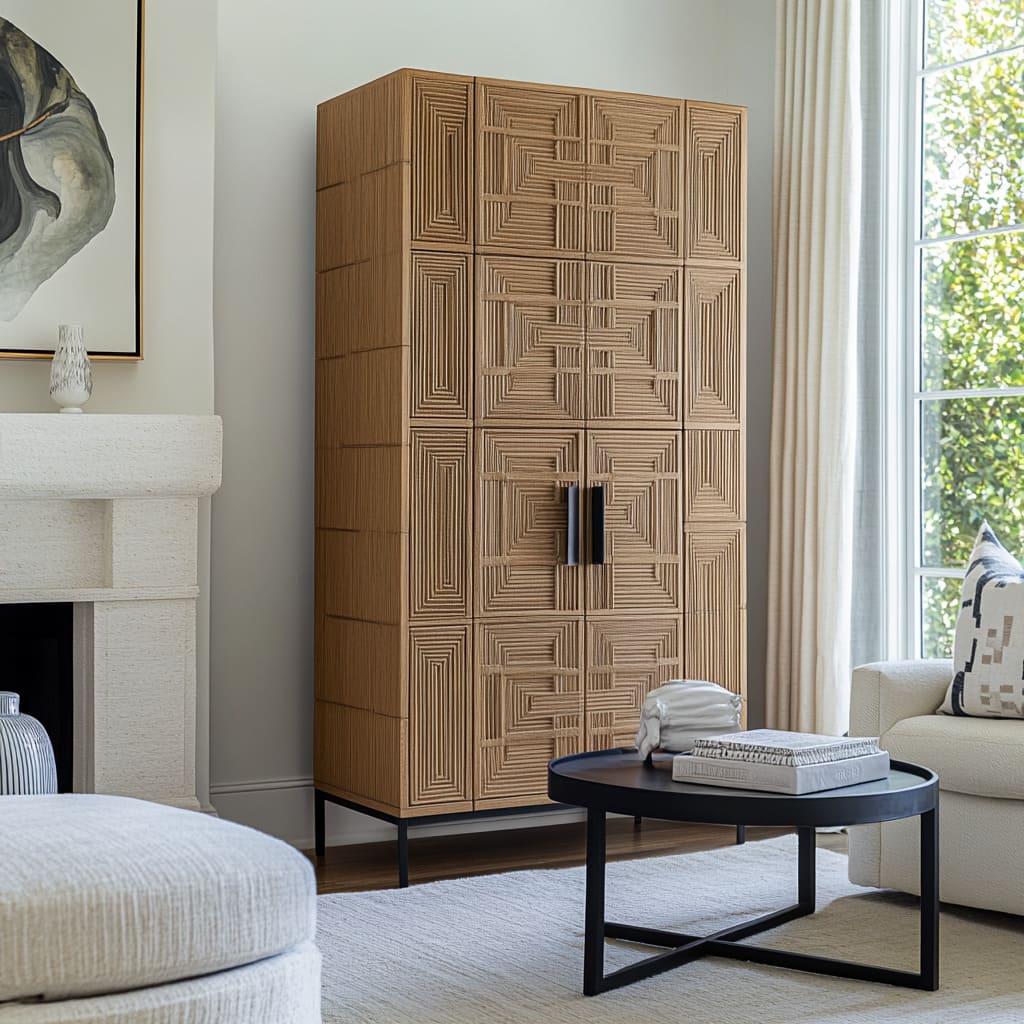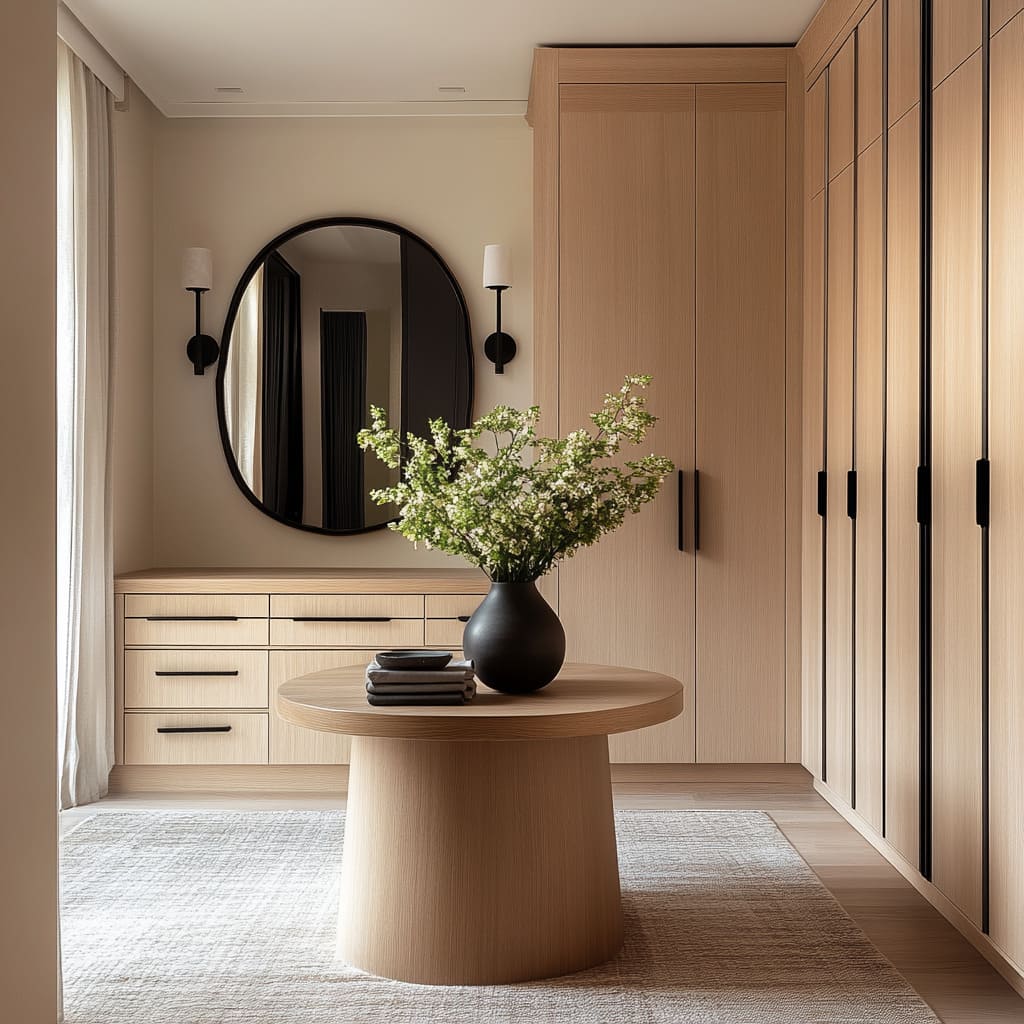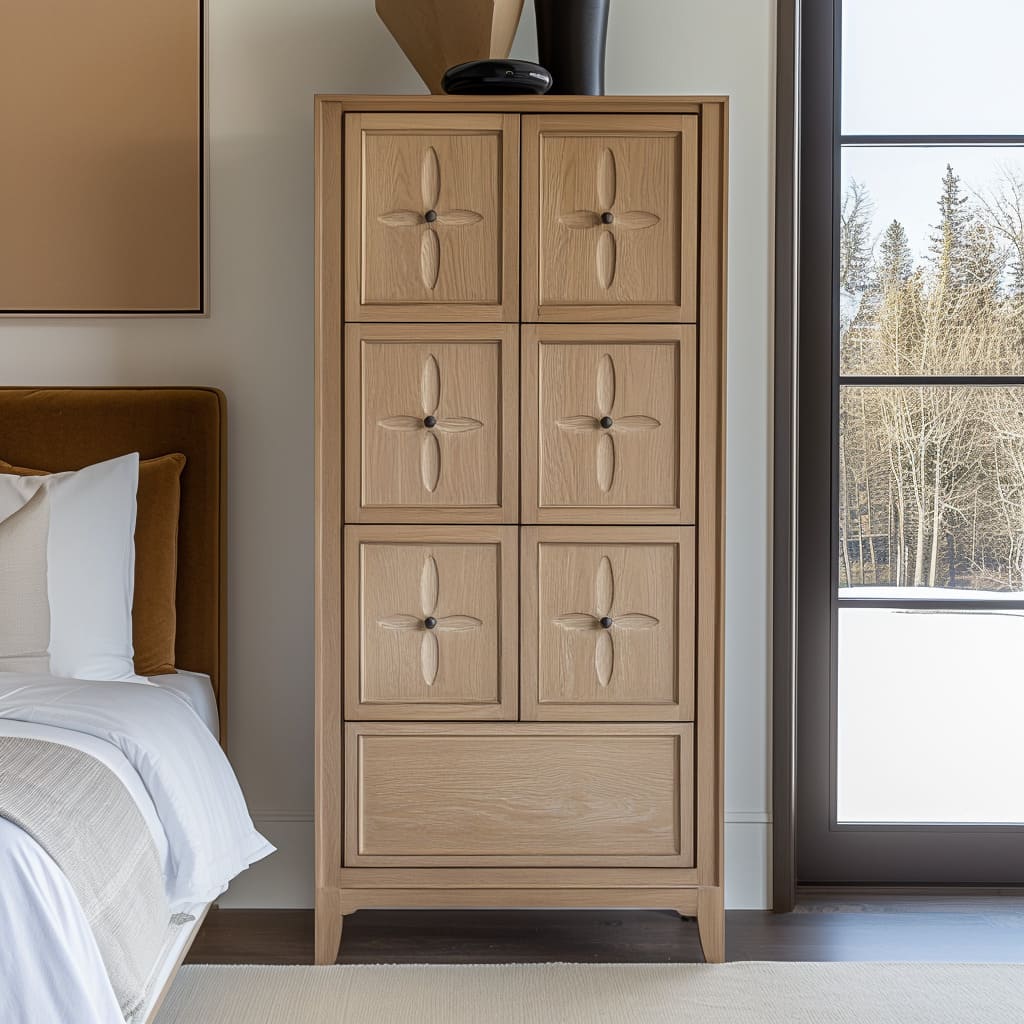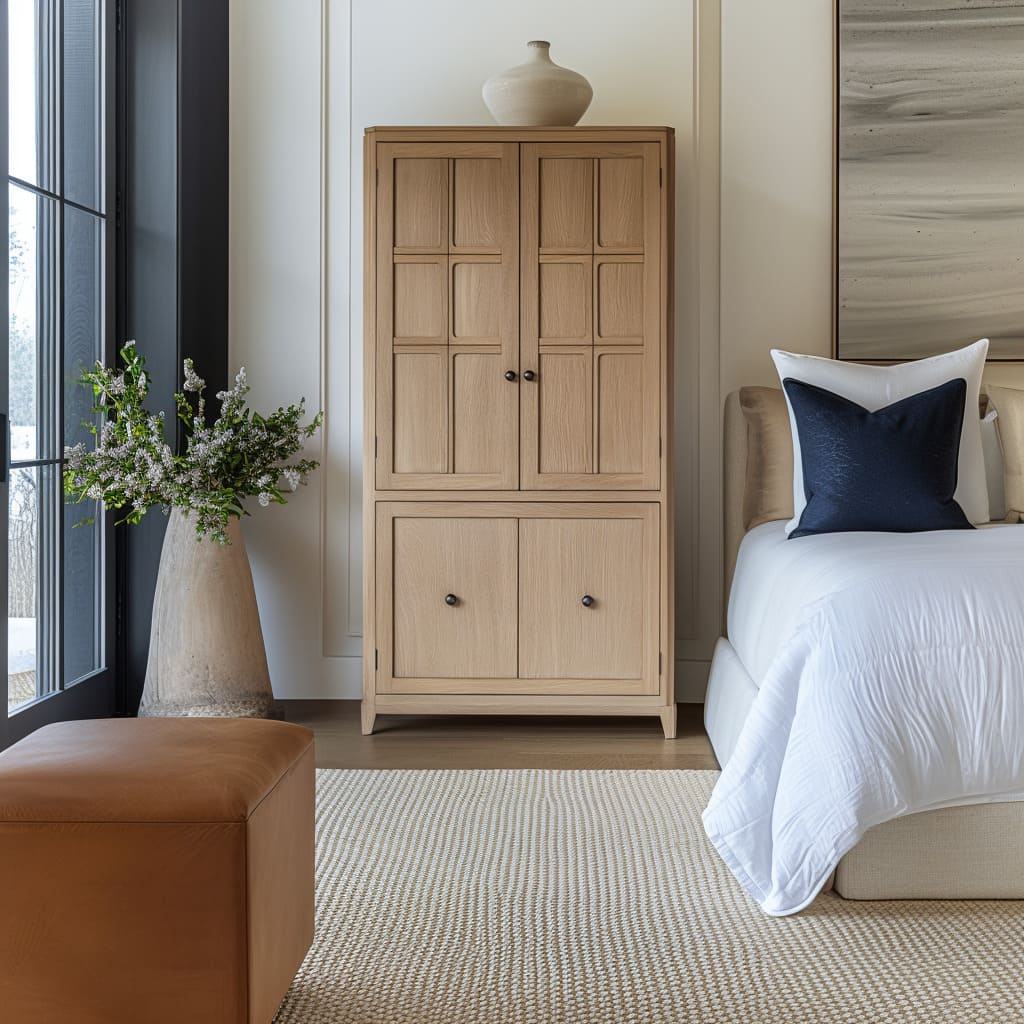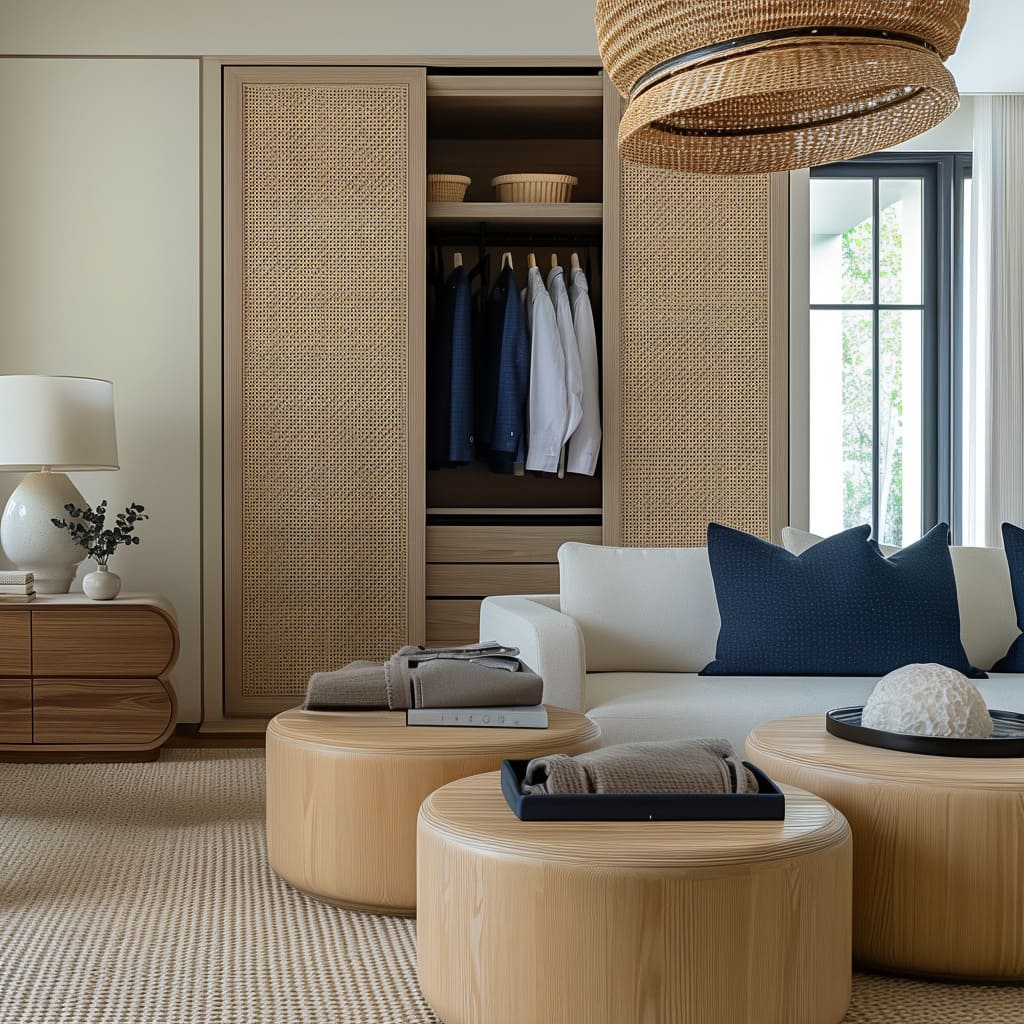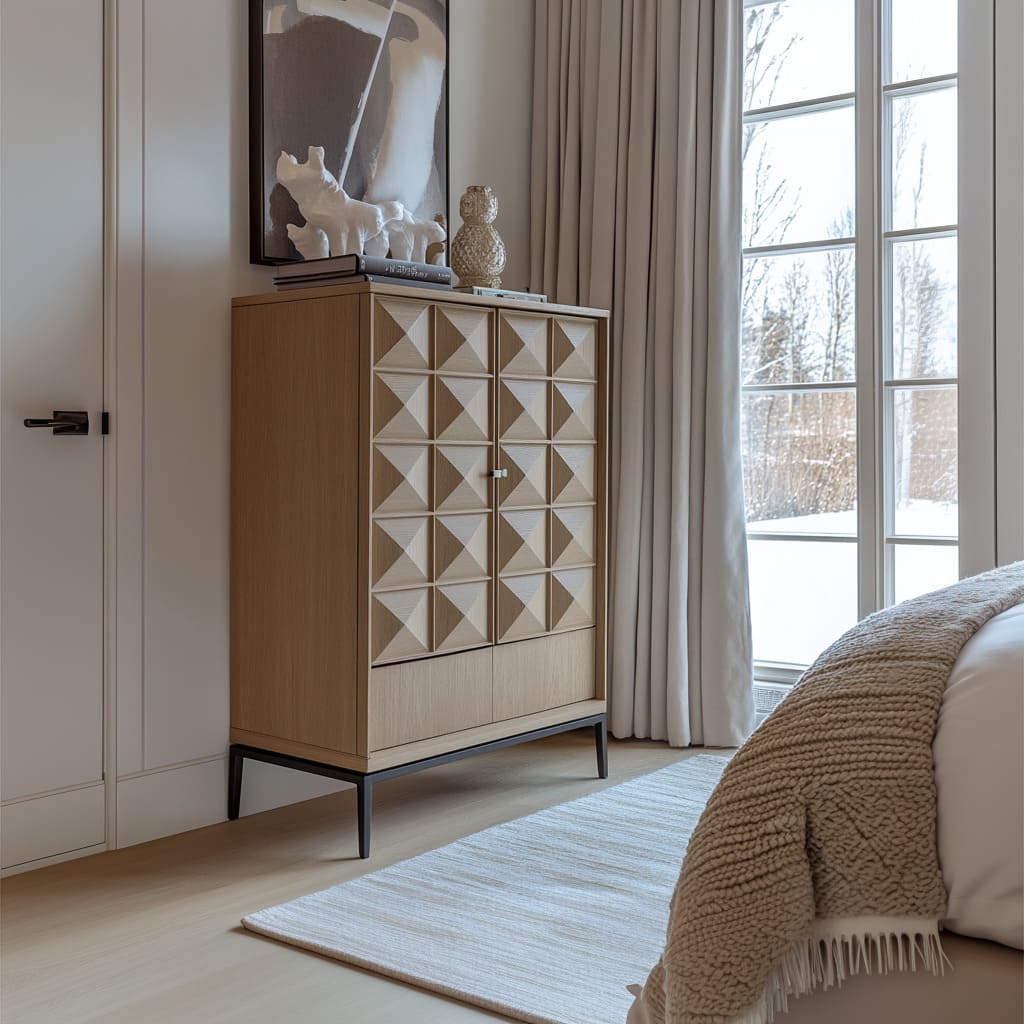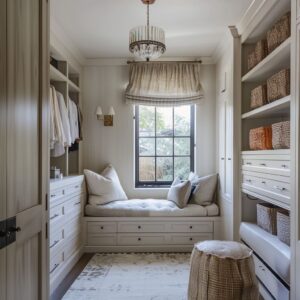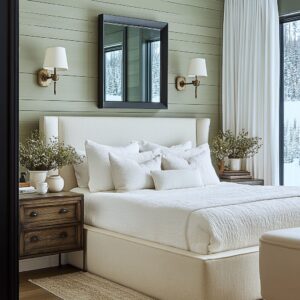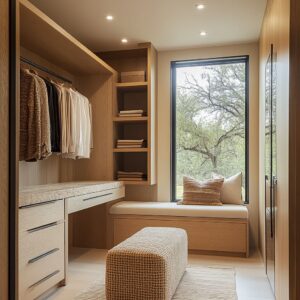Bedroom cabinets have transformed from simple storage solutions into vital components of modern interior design. Whether you’re looking to maximize functionality or add a distinctive touch to your space, today’s designs combine practicality with eye-catching details that can elevate any bedroom.
From natural materials like rattan and oak to sleek finishes in soft neutral tones, these cabinets are crafted to complement various aesthetics while meeting everyday storage needs.
Inspiration for bedroom cabinet styles comes from a blend of traditional and contemporary trends, making them adaptable to a wide range of tastes. Whether your home reflects a clean and minimalist vibe or leans toward a cozy, layered look, the right armoire can seamlessly fit into your bedroom’s design.
These versatile pieces also integrate thoughtful elements like textured panels, contrasting hardware, and practical shelving systems, ensuring both style and utility. This article explores some of the most innovative ideas in bedroom cabinetry, offering insights into how these pieces can transform the way your space feels and functions.
Whether you’re drawn to clean lines, natural textures, or creative storage solutions, these designs provide a perfect mix of aesthetics and organization. Let’s take a closer look at the thoughtful combinations and design principles that make these cabinets an essential part of any modern home.
Design Elements To Pay Attention To
Material Combinations
In modern bedroom furnishing designs, materials play a pivotal role in shaping the aesthetic and functionality of cabinetry. One standout trend is the use of natural oak and veneer finishes.
Light oak, whether in its raw form or enhanced with veneers, provides a sense of warmth and connection to the natural world. Its gentle grain patterns are a perfect foundation for cozy yet stylish bedrooms, blending seamlessly with various interior styles.
Woven rattan or cane doors are another hallmark of stylish cabinet ideas for bedrooms. These doors not only contribute to the visual texture but also serve a practical purpose, promoting ventilation and allowing soft light diffusion.
This makes them a popular choice for homeowners who value both utility and aesthetics. To balance the organic feel, matte and lacquered paints in soft neutrals such as taupe, ivory, and beige complement the wood tones, ensuring the space feels light and cohesive.
Adding to the modern charm are metal accents, especially sleek black or gold handles. These elements provide just the right amount of contrast to the natural wood and paint finishes.
Their linear shapes enhance the contemporary appeal without drawing attention away from the overall harmony of the design.
Details in Craftsmanship
The artistry of modern cabinetry lies in the attention given to intricate details, which elevate the space from functional to visually engaging. One standout feature is the use of ribbed panels.
These vertical grooves are subtle yet effective in introducing texture and emphasizing craftsmanship. They bring an understated sophistication to cabinets without overwhelming the surrounding decor.
Equally captivating are geometric patterns, often seen as intersecting squares or diamond grids. These designs add depth and interest, breaking up flat surfaces while maintaining a clean, organized look.
For those seeking a softer visual touch, arched details are an excellent choice. These curved elements, whether incorporated in doors or accents, add a nostalgic touch that nods to classic design while still feeling fresh and current.
Decor Integration
No cabinet design is complete without thoughtful decor integration, which transforms simple bedroom cabinetry into a key focal point. The tops of cabinets are often adorned with vases filled with greenery, sculptural pottery, or carefully curated stacks of books.
These elements soften the linear forms of cabinetry, tying them into the larger bedroom aesthetic while reinforcing organic and natural themes. The overall interior is carefully balanced to ensure harmony.
For example, neutral rugs and wall tones provide a subtle backdrop, allowing the textures and craftsmanship of the cabinets to stand out. This approach creates a cohesive look where every element, from furniture to decor, contributes to the room’s style and purpose.
These bedroom furnishing designs demonstrate how small details, when carefully chosen, can create a space that is both functional and visually appealing. Whether you’re inspired by these ideas for a cabinet in a bedroom or planning a larger design overhaul, these elements showcase how modern styles are about more than just looks—they’re a way to make your space feel curated, practical, and personal.
Functional and Practical Design Insights
Innovative Storage Solutions
The hallmark of modern bedroom cabinet design lies in its clever approach to storage, seamlessly integrating functionality with aesthetics. A major trend is the use of hidden storage, where the armoire doors feature smooth, uninterrupted panels.
These designs prioritize a clean and minimal look, making visible seams almost nonexistent. By eliminating visual clutter, these storage options create a sense of spaciousness, even in smaller bedrooms, while keeping belongings neatly tucked away.
Another standout innovation is the emphasis on modular configurations. Cabinets that extend from floor to ceiling, or units combining closed storage with open shelving, bring both versatility and visual interest.
The flexibility of modular systems allows homeowners to adapt the furniture layout to their specific needs, whether it’s accommodating additional shelves for books or maximizing closet space. These configurations strike a balance between utility and a polished appearance, making them a favorite choice for homeowners who value practicality without sacrificing design.
Adding to their practicality are ventilated designs, often achieved with cane or rattan paneling. While these materials add texture and warmth to a space, they also serve a functional purpose.
The breathability of these panels makes them ideal for storing delicate fabrics or items prone to moisture buildup, ensuring everything inside remains fresh and well-preserved.
Room Functionality
Modern cabinet designs go beyond simple storage to become an integral part of the room’s functionality and visual appeal. Many designs double as statement pieces, anchoring the room with their distinctive shapes, textures, or finishes.
Whether placed along a feature wall or as part of a coordinated furniture arrangement, these cabinets command attention while serving essential storage needs. Their strategic placement is another element of thoughtful design.
For example, cabinets positioned near windows not only make efficient use of wall space but also benefit from natural light, enhancing the wood grain or texture details. Similarly, designs that integrate seamlessly with nightstands or mirrors show an awareness of spatial dynamics, making the room as functional as it is beautiful.
The key is in their ability to maximize the usability of the room while maintaining a cohesive and inviting atmosphere. By merging form and function, these cabinets cater to the practical needs of everyday life while elevating the bedroom’s overall design.
These insights into storage and spatial planning underscore why modern bedroom cabinet design continues to be a cornerstone of contemporary interiors.
Key Design Principles To Follow
Balance
The thoughtful balance in bedroom cabinet storage ideas ensures these designs feel both functional and visually appealing. The use of light finishes—like oak and soft veneer—forms the foundation, while contrasting elements such as black handles or decor pieces provide a grounded, dynamic touch.
This combination creates a harmonious visual equilibrium that prevents the designs from feeling overly minimal or stark. For example, a cabinet with neutral tones can be accented by bold black hardware or a striking vase, offering just enough contrast to draw the eye without overwhelming the space.
Symmetry plays a critical role in achieving this balance, as seen in designs with evenly divided shelving or aligned drawer handles. These features not only enhance the visual order but also bring a sense of refinement to the room.
The placement of decor items, such as pairs of vases or books arranged evenly, complements the structured design, reinforcing a sense of purpose and cohesion. This measured approach ensures that bedroom cabinet designs integrate seamlessly into the overall aesthetic while remaining practical.
Proportion and Scale
Successful bedroom furniture design ideas are all about understanding proportion and scale, making sure each piece feels intentional in the space. Tall cabinets extending to the ceiling are perfectly suited for larger or taller rooms, emphasizing height and making use of otherwise wasted vertical space.
On the other hand, lower-profile dressers and storage units fit comfortably into cozier spaces, avoiding the risk of feeling overpowering. Wide drawers and large cabinet panels exude a sense of stability and purpose, grounding the room’s layout.
These substantial elements are balanced by sleek, minimal hardware, such as slim black handles, which maintain a modern aesthetic while ensuring the designs don’t appear bulky or dated. This balance of substantial and slender components ensures that the furniture remains versatile, appealing to homeowners who value both function and style.
Texture and Contrast
A key feature of these designs is their ability to blend smooth finishes and textured materials, creating a tactile richness that enhances the room’s depth. Textures such as ribbed wood, woven rattan, and cane panels contrast with sleek lacquer or veneer finishes, offering a layered look that feels engaging without being visually overwhelming.
This interplay between smooth and textured surfaces draws attention to the finer details, showcasing the craftsmanship behind each piece. Flat, neutral walls provide an ideal backdrop for these textural elements, allowing them to stand out without competition.
By keeping the walls understated, the cabinets take center stage, creating a cohesive design where every element feels deliberate. This thoughtful approach ensures that the cabinets not only function as storage but also serve as statement pieces that enhance the room’s overall design.
Color Theory
The color palettes used in these designs are carefully curated to promote a calming and cohesive bedroom environment. Soft, natural hues like beige, taupe, and light oak dominate, contributing to a tranquil atmosphere ideal for rest and relaxation.
However, these light tones are often paired with darker accents, such as black hardware or decor elements, to provide depth and grounding.
This combination of light and dark prevents the space from feeling overly pale or washed out, instead creating a well-rounded palette that feels intentional and inviting. Neutral-toned rugs and accessories help tie the look together, further enhancing the sense of cohesion.
By incorporating these thoughtful color choices, bedroom cabinet storage ideas effectively combine practicality with visual appeal, ensuring they remain timeless and versatile for a variety of interior styles.
Interplay with Room Interiors
Wall Finishes
In any thoughtfully curated bedroom with cabinet design, walls play a pivotal role in setting the tone and mood of the space. Neutral tones, like soft white, off-white, or creamy beige, dominate wall finishes.
These light hues not only enhance the perception of space but also provide an ideal backdrop for textured cabinets, allowing their materials and intricate designs to take center stage. For rooms featuring vertical grooves or ribbed panels on cabinetry, matching wall paneling offers a unified design narrative, tying the room’s elements together.
This alignment creates a subtle rhythm, allowing each feature to complement the other without overwhelming the eye.
Beyond color, the finish of the walls is often matte or slightly textured, ensuring they feel warm and inviting rather than stark. Such finishes enhance the layered textures of cool bedroom furniture, allowing the interplay between smooth wood veneers and tactile cane or rattan panels to shine.
Strategic use of paneling or minimal trims further refines the aesthetic, making the walls a supporting yet essential component of the overall design.
Flooring
Flooring choices in these interiors are far from arbitrary—they are carefully considered to work seamlessly with the cabinetry. Light-toned hardwood floors, such as oak or maple, are particularly popular, creating a cohesive flow that feels organic and timeless.
The continuity between the cabinetry and the flooring ensures that the room feels balanced, with each element contributing to a harmonious atmosphere. However, to avoid visual monotony, textured rugs are introduced.
Whether it’s a natural fiber rug in soft beige or a subtly patterned weave, these accents break up the uniformity of the wood tones and add a layer of softness underfoot. These rugs often echo the warm, neutral palette of the cabinets while introducing texture, making the space feel cozy and grounded.
Together, the flooring and cabinetry form the foundation of the room, proving that even subtle design choices can have a transformative effect.
Natural Light
The strategic placement of cabinets near windows amplifies the role of natural light in the space, showcasing the textures and materials in ways artificial lighting simply can’t replicate. As sunlight filters through the room, it dances across the grooved wood, woven rattan, or lacquered surfaces, creating an ever-changing display of light and shadow.
This dynamic effect not only highlights the craftsmanship of the cabinets but also infuses the room with a sense of vitality. In addition, natural light enhances the soft tones of the cabinetry, making the materials appear richer and more inviting throughout the day.
By reflecting off light-colored walls and floors, it brightens the space further, ensuring that even compact bedrooms feel airy and expansive. This thoughtful integration of light and design makes the room functional and visually engaging without relying on excessive decorative elements.
A Holistic Approach
What truly sets these bedroom interiors apart is their ability to harmonize all elements—walls, flooring, cabinetry, and decor. The cabinets act as both functional storage solutions and aesthetic focal points, their textures and tones carefully chosen to work in concert with the surrounding finishes.
Incorporating cool bedroom furniture into these spaces elevates the sense of modernity while maintaining a warm, approachable vibe. For homeowners, this blend of practicality and design serves as a blueprint for creating rooms that feel both stylish and livable.
Whether it’s through the soft neutral tones of the walls, the warmth of hardwood flooring, or the strategic use of natural light, each element contributes to a space that is cohesive and inviting. By focusing on how cabinets interact with the room as a whole, these designs go beyond simple utility to offer a complete sensory experience.
Sophisticated Combinations
Mixed Styles in Single Pieces
The modern bedroom cupboard designs showcased in these interiors exemplify an artful blend of styles, making them both functional and visually intriguing. Sleek, minimalist frames with clean edges pair seamlessly with traditional details, such as arched doorways or intricate cane weaving.
This blend allows the cabinets to transition effortlessly between various aesthetics, creating versatile focal points in the room. For example, a contemporary cabinet featuring ribbed panels might incorporate arched forms reminiscent of classic designs, offering a perfect balance between timeless elegance and modern trends.
These hybrid pieces provide homeowners with flexibility, enabling them to adapt their decor without compromising on style. The thoughtful integration of mixed styles ensures that no single design feels out of place, even in eclectic interiors.
This fusion appeals to homeowners who appreciate a layered, personalized approach to bedroom storage cupboard ideas while offering a coherent and unified look. Cabinets designed with these combinations excel in blending practicality with aesthetics, enhancing the room’s overall ambiance without overwhelming its simplicity.
Dual-Purpose Furniture
One of the defining features of these cabinets is their ability to serve multiple functions simultaneously. Incorporating shelving units around closed cupboards, for example, allows homeowners to display cherished items like books, art, or vases while maintaining hidden storage for essentials.
This dual-purpose approach ensures that the bedroom remains organized and free of visual clutter, while still offering a personal touch through displayed decor. These versatile configurations often include open shelving flanking larger cabinets or drawers, creating opportunities for layering textures and colors.
The thoughtful arrangement of display and concealed storage spaces makes these cabinets ideal for maximizing room functionality. Homeowners can enjoy the practicality of modern bedroom cupboard designs while also adding character and individuality to their interiors.
Biophilic Design
Bringing elements of the natural world indoors, biophilic design plays a key role in the aesthetic and functional appeal of these cabinets. Organic materials such as rattan and light wood finishes serve as grounding elements, while the addition of greenery in the surrounding decor reinforces the connection to nature.
This approach creates a calming and refreshing atmosphere, ideal for a restful bedroom environment. The subtle incorporation of nature-inspired textures, like cane weaving, mirrors the organic patterns found in natural landscapes.
Combined with the inclusion of vases filled with fresh or dried foliage, these designs foster a tranquil yet modern vibe. This trend not only enhances the aesthetic value of the cabinets but also contributes to the overall well-being of the space, offering homeowners a sanctuary-like environment.
Versatility Across Styles
Perhaps one of the most compelling aspects of these cabinets is their ability to adapt to a wide variety of design styles. Whether incorporated into Japandi-inspired spaces with their clean lines and natural materials, transitional interiors seeking a balance between traditional and contemporary elements, or coastal homes emphasizing light, airy palettes, these pieces offer unmatched versatility.
Their neutral tones and understated textures make them the perfect canvas for various design narratives. For instance, in a Japandi-inspired bedroom, the simplicity of the cabinets complements the minimalistic aesthetic, while their natural finishes echo the principles of harmony and balance.
Similarly, transitional bedrooms benefit from the cabinets’ ability to bridge the gap between classic and modern design. This adaptability ensures that the cabinets are not just practical storage solutions but integral components of the room’s style and character.
Enhanced Perception of Space
Strategic cabinet designs can significantly influence how spacious a bedroom feels. Tall cabinets draw the eye upward, making ceilings appear higher and adding an element of grandeur to the room.
On the other hand, horizontal units with wide drawers create a visual flow that enhances the perceived width of the space. These proportional considerations ensure that cabinets not only serve their intended purpose but also contribute to the room’s overall sense of scale and dimension.
The integration of these cabinets with thoughtful room layouts emphasizes their versatility and ability to elevate the functionality and aesthetic of any bedroom. Whether serving as a statement piece or blending seamlessly with the room’s broader design, these cabinets provide practical solutions for modern homeowners.
The flexibility of these bedroom storage cupboard ideas ensures they remain relevant and stylish, regardless of evolving design trends.
Design Ideas and Inspiration
For Statement Furniture
Creating standout pieces in a bedroom often involves subtle but intentional design choices. For cupboard designs for bedroom interiors, incorporating geometric or ribbed paneling adds an element of understated sophistication.
These design features bring depth and texture without the need for vibrant colors or ornate detailing, keeping the focus on the craftsmanship and material quality. Ribbed designs, for example, introduce a sense of rhythm to the room’s decor, while geometric patterns offer a bold yet refined statement.
Opting for cane or rattan cabinets not only adds visual interest but also ensures breathability, making them ideal for storing items like linens or delicate fabrics that require proper airflow. These statement furniture pieces work best in rooms where minimalism is key, enhancing the ambiance without overpowering other elements.
When used thoughtfully, such cabinets become more than storage solutions—they act as focal points that anchor the room’s design. Whether placed in a modern or transitional setting, they align with a wide range of aesthetic preferences, making them versatile for homes with diverse stylistic influences.
Statement cabinets that feature unique materials like cane emphasize both functionality and beauty, ensuring their presence is practical and eye-catching.
Color and Finish Pairings
The interplay between cabinet finishes and surrounding colors sets the tone for the bedroom’s overall atmosphere. Pairing light oak or beige-toned cabinets with muted wall shades, such as soft greys or pastel tones, creates a calm and inviting environment.
These subdued combinations allow the natural texture of the cabinet surfaces to take center stage, offering a tactile and visual connection to the space. To avoid a monotonous palette, adding darker elements such as black or matte bronze handles provides subtle contrast, grounding the design without detracting from its light and airy quality.
This balanced approach ensures that cupboard wardrobe ideas feel cohesive while allowing room for personal touches. For example, using a slightly darker floor finish can anchor light cabinetry, making the space feel well-composed.
On the flip side, lighter-colored rugs and linens can enhance the brightness, reflecting more natural light and making smaller rooms appear more spacious. These carefully chosen pairings demonstrate how even subtle changes can elevate the aesthetic harmony of a bedroom.
Decor Tips
When styling cabinet tops, less is often more. The clean lines and textures of modern cupboard designs for bedroom setups shine best when decor is kept minimal.
Consider placing monochromatic vases or a stack of neutral-toned books to subtly enhance the visual appeal. These decorative elements can draw attention to the craftsmanship of the furniture without overshadowing it.
Using greenery in small doses, such as a potted plant or sprig in a vase, adds a refreshing natural touch that complements wooden finishes.
For multi-shelved cabinets, the decor within should reflect a sense of balance and order. Grouping items in sets of two or three creates a harmonious visual flow, preventing the design from appearing cluttered.
Neutral decor tones paired with natural textures, such as ceramic or stone, further emphasize the organic feel of these cabinets while maintaining the room’s tranquil vibe.
Spatial Layouts
Strategic placement of cabinets within the bedroom plays a crucial role in optimizing both functionality and aesthetics. Taller cabinets positioned near windows or in less-trafficked corners prevent them from dominating the room’s central space.
This arrangement allows natural light to enhance the cabinet’s textures and finishes, creating subtle shadow play that adds depth to its appearance. When it comes to lower cabinets or wide drawer units, placing them near heavier furniture like beds or sofas ensures balance and avoids visual overcrowding.
Positioning cabinets in alignment with architectural elements, such as along accent walls or below slanted ceilings, maximizes the room’s layout. These thoughtful placements ensure the cabinets contribute to the room’s overall flow without obstructing movement or light.
Ultimately, whether you’re designing around tall wardrobes or compact storage solutions, the layout should prioritize ease of use and visual harmony. These design ideas provide homeowners with practical yet stylish approaches to making their bedrooms both functional and inviting.
Conclusion
The bedroom armoire ideas capture a refined balance between functionality and aesthetic appeal, showcasing designs that seamlessly blend into various home interiors. With a strong focus on simplicity, the use of natural materials like rattan, cane, and ribbed wood emphasizes warmth and textural depth.
These elements are thoughtfully paired with soft, neutral tones, ensuring that the cabinets remain versatile enough to complement any modern or transitional bedroom theme. Beyond their practicality, these cabinets serve as centerpiece furnishings that tie together the overall design of a room.
One of the standout features of these designs is their ability to adapt to changing trends while maintaining a timeless quality. Incorporating latest cupboard designs for bedrooms, these cabinets demonstrate an intelligent use of material combinations and proportions.
Their understated color palettes are thoughtfully contrasted with darker handles and subtle decor, giving each piece a well-rounded and balanced appearance. This approach makes the furniture feel both inviting and sophisticated, without overwhelming the room.
Moreover, these cabinets extend beyond being simple storage units—they redefine bedroom layouts with thoughtful placement and clever integrations. Whether positioned near windows to play with natural light or paired with rugs and complementary furnishings, they contribute to a cohesive design narrative.
By prioritizing clean lines and natural textures, these pieces enhance the flow and functionality of the bedroom, creating spaces that feel organized yet comfortable.
Ultimately, these cabinet designs embody a modern approach to furniture, prioritizing practicality without compromising on beauty. They inspire homeowners to reimagine their bedrooms as multifunctional spaces where storage meets style.
With endless possibilities for material and decor combinations, these cabinets set the standard for future-focused bedroom designs, providing ideas that are both timeless and adaptable for years to come.

